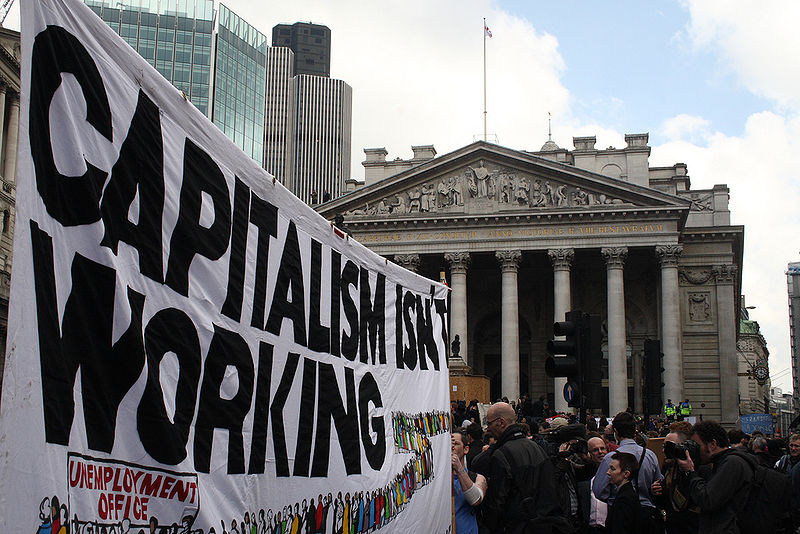We present the International Marxist Tendency's world perspectives for 2018: as debated, amended and agreed upon by delegates at our 2018 World Congress. The following is the IMT's analysis of the current situation in world politics, and predictions about where we are headed.
Ten years after the Crash
Ten years have passed since the financial crash of 2008. This was one of those defining moments in world history that mark a fundamental change in the situation, like 1914, 1917, 1929 and 1939-45. It is therefore an appropriate moment to draw a balance sheet of the past decade.
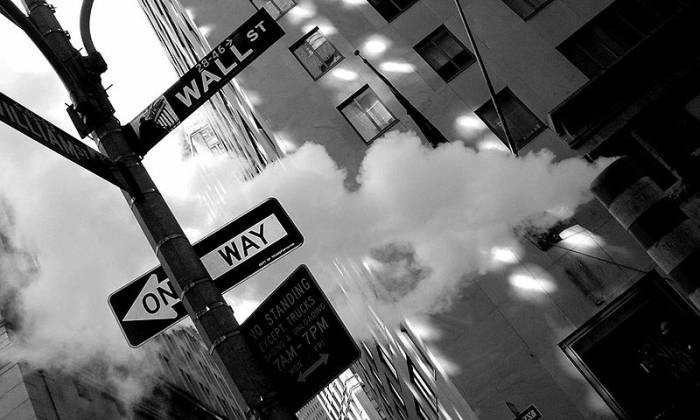 Image: Paul Sparkes
Image: Paul Sparkes
This crisis was qualitatively different from any other in the past. It was not a normal cyclical crisis, but a reflection of the organic crisis of capitalism. A decade after the collapse of 2008, the bourgeoisie is still struggling to extricate itself from the crisis that destroyed the equilibrium of the capitalist system. To the very limited degree that one can speak of a recovery, it is a very partial one. In fact, it is the weakest economic recovery in history. Even in the 1930s there was a bigger recovery. And certain things flow from this.
Ten years ago, we predicted that all of the attempts of the bourgeoisie to restore the economic equilibrium would destroy the political and social equilibrium. That has now been confirmed by events on a world scale. In one country after another the attempts of governments to impose austerity in a desperate effort to get the economy moving (which they have failed to do) have prepared social explosions of an absolutely unprecedented character.
“Concentrated economics”
Lenin said politics is concentrated economics. In the last analysis, all these crises are an expression of the impasse of capitalism which is no longer capable of developing the productive forces as it did in the past. This does not mean, of course, that there can no longer be any development of the productive forces.
Neither Marx nor Lenin or Trotsky have ever said that there was an absolute ceiling on the development of the productive forces under capitalism. It is a relative, not an absolute phenomenon. There can always be some development, as there has been in China in the last period. But on a world scale there is nothing compared to the development of the productive forces in the second half of the 20th century after the Second World War.
Marxism explains that the secret to the viability of any economic system is the achievement of the maximum economy of labour time. One of the most important elements in the development of capitalism was precisely the growth in the productivity of labour. For 200 years, capitalism raised the productivity of human labour power to a level undreamt of in the past. But this progress is now reaching its limits.
A study on productivity by the Center for Economic and Policy Research in September 2015 found that, between 2007 and 2012, global productivity grew at annual rate of 0.5%; half what it had been in the period 1996-2006. However, in the more recent period of 2012-14 it had ground to a complete halt at zero percent. In countries like Brazil and Mexico it was actually negative. As the report states, “This is one of the most disturbing and, no doubt, important phenomena affecting the world economy.”
These figures are a sure indication that capitalism now finds itself in a systemic crisis. The sluggish growth of the productivity of labour – and in some cases its fall – is a striking symptom of the impasse of capitalism, which is no longer able to achieve the big successes of the past.
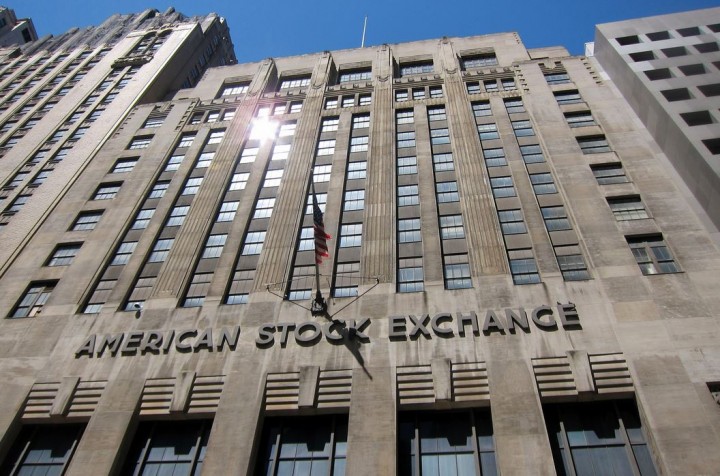
The source of the problem lies in historically low levels of investment: gross capital formation in the European Union and the United States has fallen below 20% of GDP for the first time since the 1960s, while capital consumption and depreciation is rising. In the former colonial world, the boom in raw material prices sparked a brief increase in investment, but it has fallen again over the past few years.
This failure to invest in production is not the result of the lack of money. On the contrary, the giant corporations are swimming in cash. Adam Davidson, writing in The New York Times in January 2016, stated that, “American businesses currently have $1.9 trillion in cash, just sitting around”… this “state of affairs [is] unparalleled in economic history…” The author of the article considers this a “mystery” but what it shows is that the capitalists do not have profitable fields of investment in the present state of the world economy.
More recent data by the US Federal Reserve puts the amount of “non-financial companies’ liquid assets, which include hard currency, foreign deposits, money-market and mutual-fund shares” at a “record $2.4 trillion in the third quarter” of 2017.
The system is literally drowning in a surfeit of wealth. It is like the sorcerer's apprentice who has conjured up forces that he cannot control. The productive forces have the potential to produce a mass of commodities that cannot be absorbed by the markets.
This inability to make productive use of the colossal amounts of surplus value extracted from the sweat and blood of the workers is the final condemnation of capitalism. Overproduction is reflected in a general crisis of the world economy, which is in a very fragile state. Cheap credit no longer serves to stimulate investment. What is the point in investing to create new productive forces when there are no markets for the existing production?
A new recovery?
Every day the press proclaims a recovery. In the best case, there is a slight upturn in GDP within a generalised context of long term stagnation. For Marxists there is no surprise in this; even in periods of decline the system continues to move in cycles and after a long period of decline or stagnation a small recovery is to be expected. However, it is of such a weak nature that it amounts to no substantial recovery and will not last.
The limited growth comes against a background of ultra-loose monetary policy. The Federal Reserve kept the base rate at just above zero from the autumn of 2008 until the beginning of 2017. The European Central Bank also lowered their rate to just above zero.
Real estate bubbles exist in housing markets in Britain, Canada, China and Scandinavia. The stock markets have not merely recovered but have exceeded their 2007 valuations. The Dow Jones has managed to not only exceed, but increase its valuation by 36%. The price over earnings ratio (that is, the price an investor is paying for $1 of a company's earnings or profit) has reached its third highest peak in history (the previous two being 1929 and 2000). All this is indicative, not of a healthy recovery, but of another crisis in the making. It also has the effect of transferring huge amounts of money to the capitalist class whose assets have increased in value with the influx of new credit.
The limits of credit
The reason for the present impasse is that, in the decades prior to 2008, capitalism not only reached its limits but went far beyond its “natural” limits. The unprecedented expansion of credit and debt is partly what enabled capitalism to overcome the constraints of the market and overproduction. On the other hand, there was the enormous expansion of world trade and an intensification of the international division of labour.
Marx explained that one of the ways capitalism gets around the limits of the market and the tendency for the rate of profit to fall is through the massive expansion of credit and of increasing world trade (“globalisation”), which partially, and for a limited period of a few decades, enabled it to get around the other key contradiction: the limitations of the nation state. But both of these solutions have limited effects and have now turned into their opposite.
Historically, the US has had a total debt (government and private) of around 100-180% of GDP. However, in the late 1980s total debt reached 200%, and it continued to grow until 2009, reaching a peak of around 300%. Japan, Britain, Spain, France, Italy and South Korea all have debt levels in excess of 300%. World debt now stands at $217tn or 327% of GDP, the highest in history.
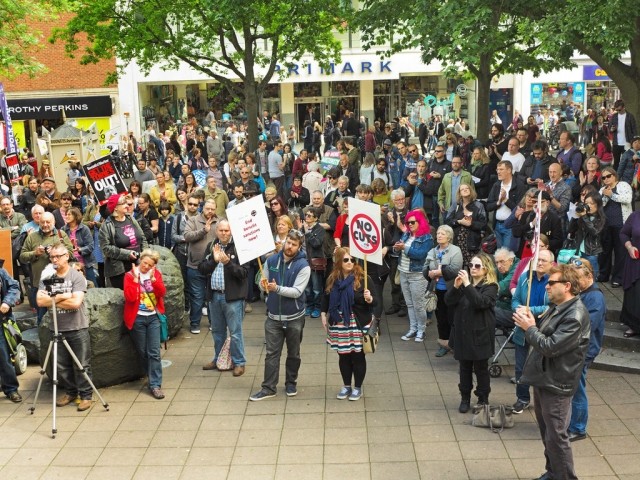 Image: public domain
Image: public domain
Marx pointed out in The Communist Manifesto that the bourgeoisie solves crises today only by paving the way for bigger crises in the future. What have they achieved over the past decade with all the pain, austerity and suffering? Their aim was to reduce the deficit and the huge unprecedented mountain of debt that had been built up as a result of the previous period.
All they have done is to convert what was a gigantic black hole in the private banks into a huge black hole in the public finances. The banks were standing on the brink of an abyss and they were only saved by the intervention of the state, which saved them by giving them trillions from the public purse. The problem is that the state does not have any money except what it can squeeze from the taxpayers.
The question is therefore: who pays? It is well known that the rich do not pay much in taxes. They have a thousand ways of avoiding that painful necessity. The working class must pay, the middle class must pay, the unemployed must pay, the sick must pay, the schools must pay. Everyone must pay except for the rich, who have become richer and richer even in this period of “austerity”.
Has all this solved anything? Seven out of the ten biggest economies in the world run annual government deficits in excess of 3% of GDP, and only Germany has less than a 2% deficit. Debt is rising everywhere. There is no way to get out of the crisis unless and until these debts have been wiped out one way or another. And how does one eliminate the public debt? Naturally you place the entire burden on the shoulders of the poorest and most vulnerable sections of society.
The scenario that we are witnessing internationally is really unprecedented. And we are speaking here only of the advanced capitalist countries. The situation in the so-called Third World is another matter. Here the picture is one of unrelieved misery, unimaginable suffering, starvation and degradation for billions of men, women and children.
The threat of protectionism
For decades, world trade grew much faster than production, providing the motor force for the growth of the world economy. However, in the recent period, the growth of world trade has slowed to a level lower than that of GDP. Global trade as a percentage of GDP peaked at 61% twice, in 2008 and 2011, but now it has fallen to 58%.
The World Trade Organisation has expressed concern that national governments may be tempted to defend their own markets with protectionist measures and that these would in turn impact negatively on trade growth. As if to confirm these fears, Donald Trump blunders onto the scene like an elephant in a china shop. His policy of “America first” is itself a reflection of the global crisis. He wishes to “make America great again” at the expense of the rest of the world. That is to say, he wishes to use America’s muscle to grab an increased share of world markets.
In the last few years the US capitalists have been struggling to put together a number of trade deals with Europe, America and Asia. The first thing Trump did was to tear up the TPP and the TTIP. He also threatens to destroy NAFTA if he cannot get a deal whereby Mexico and Canada sacrifice their interests for the benefit of the USA and he is threatening to paralyse the WTO by blocking the replacements of judges to its tribunals.
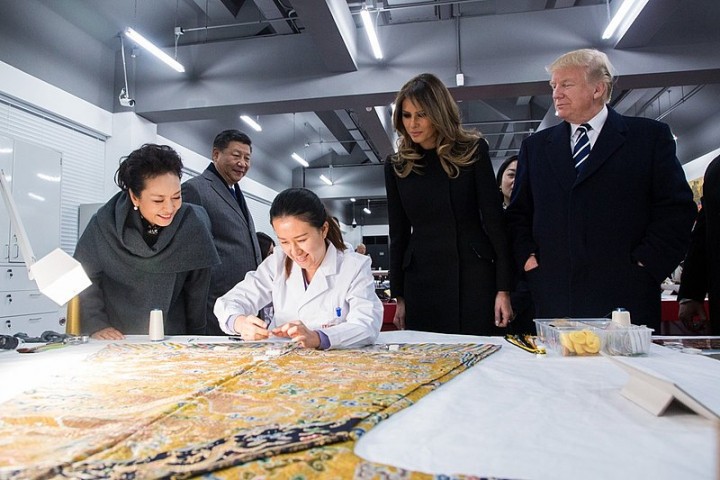 Image: The White House
Image: The White House
China has a huge trade surplus with the USA, a record-high $275.81 billion for 2017, and this is one of the main reasons that Trump complains that China is harming the US economy. During the election campaign Trump accused China of “raping America”, stealing US jobs, etc. Since then he was obliged to moderate his language in the hope of getting China to put pressure on North Korea. But that aim was not achieved and the contradictions between America and China remain unresolved. Here already is the outline of a future trade war between America and China.
He is not the only one pursuing this policy. Since the beginning of the crisis the advanced capitalist countries have been taking measures to increase their trade surpluses. This has partly been done by a number of protectionist moves. The US (under Obama) became the world leader in protectionism, but also the UK, Spain, Germany and France are more protectionist than China.
It must be remembered that it was protectionism that sharpened the crash of 1929 as an important element of the great Depression of the 1930s. If protectionism takes hold, it can cause the whole fragile structure of world trade to come crashing down, with the most serious consequences.
The USA – an unprecedented crisis
The relative weakening of the US since the Second World War is shown in the fact that in 1945 more than 50% of world GDP was produced in the United States, whereas now this figure is around 20%. When we refer to the relative weakening of US imperialism, we should not, however, exaggerate the process. By relative decline, we mean that it has been weakened and cannot play the same role it did in the past, as can be seen in the Syrian crisis. The US, nonetheless, remains by far the dominant superpower on a world scale and no other power is in a position to replace it, as the US replaced Britain in the past, for example.
This relative decline has had an effect on both its ability to dominate the world economically, politically and diplomatically and on its ability to provide the workers of America with the standard of living that was behind the relative internal stability of the past. This reality has now seeped into the consciousness of the US masses.
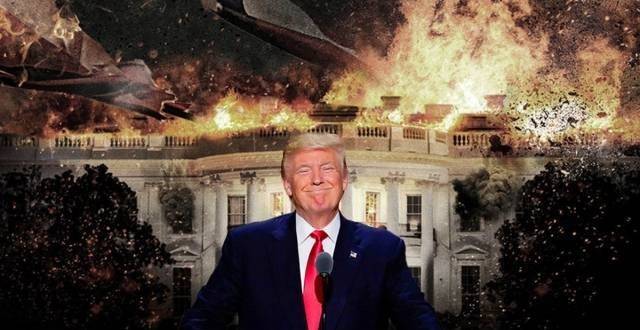 Image: Socialist Appeal
Image: Socialist Appeal
The American dream is dead. It has been replaced by the American nightmare. The dream is finished and there is no way they can recover it. The change in consciousness in America was revealed in a peculiar way during the presidential elections of November 2016. For a hundred years, the stability of American capitalism was based on two parties: the Democrats and Republicans. These two parties alternated in office for all that time.
There is huge discontent and a burning desire for change. We already saw that in the vote for Obama, who demagogically promised a change. Millions of people who did not normally vote were queuing up to vote for a black President. They did so twice, but in the end there was no change. Thus a mood of anger, bitterness and frustration grew, particularly amongst the poorest sections.
This mood was clearly expressed in the campaign of Bernie Sanders. At first hardly anybody knew Bernie Sanders, whereas everybody knew Hillary Clinton. Yet when he talked about a political revolution against the billionaire class it struck a chord with many people, especially (but not only) the youth. There were mass meetings of tens of thousands to support Bernie Sanders. At least one study said that if Sanders had stood against Trump, he could have won. But inevitably he was manoeuvred out by the Democratic Party machine. Worse still, he accepted it, which caused a certain element of demoralisation among his supporters.
The ruling class likes to have people they can control, people like Hillary Clinton. They did not and do not want Trump because he is a maverick who suffers from an extreme case of egomania and is therefore difficult to control. Hillary Clinton is an agent of big business. Trump represents the same class but he has his own ideas as to how this should be done. During the election campaign he demagogically appealed to the workers. For the first time in recent memory, a presidential candidate referred to the working class (as did Bernie Sanders). That was unheard of. Even most of the left-wing liberals and trade union leaders always referred to the “middle class”.
The establishment was desperate to stop Trump. But they failed. The ruling class was against this demagogic interloper; the Democrats were against him of course, and the majority of the Republicans were also against him. All the media were against him. He even succeeded in alienating Fox News for a time. The media is without doubt a powerful instrument in the hands of the ruling class. And yet he won.
This was a political earthquake. But how does one explain it? Trump is a reactionary, but he is also a skilful demagogue who directed his appeals to the poor, alienated unemployed and workers in the rustbelt: offering them jobs, denouncing the existing state of affairs and the privileged Washington establishment. In this way he connected with the general mood of anger and discontent.
Bernie Sanders connected with the same mood. But he was predictably sabotaged by the Democratic Party machine. And when Sanders finally capitulated and called for support for Hillary Clinton, many saw Trump as the “lesser evil,” and he went on to win the election. Many people who would have voted for Sanders sat out the election or thought, “If we can’t vote for Sanders, we’ll vote for Trump”.
Trump’s campaign was marked by the galvanisation and mobilisation of a section of the electorate which was previously inert and achieved more absolute votes than any Republican candidate in history, though he won a lower overall percentage than Republican candidate Mitt Romney in 2012. However, his victory also exposed the opacity and undemocratic nature of the US Electoral College system, which worked to his advantage in spite of Trump winning almost three million votes fewer than Hillary Clinton.
The vast majority of the bourgeoisie was not happy about this unexpected turn in events. But neither, at first, were they unduly concerned. They have a thousand ways of controlling a difficult politician. Initially they tried to comfort themselves with the idea that what Trump said during the election campaign was just propaganda, and that he would behave rationally once he entered the White House (that is to say, he would take his orders from the ruling class). But they were mistaken. The man in the White House proved difficult to control.
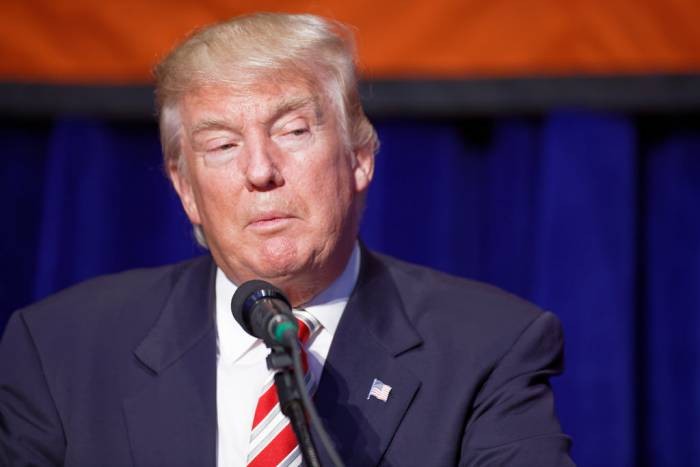 Image: Flickr, Michael Vadon
Image: Flickr, Michael Vadon
The Democrats had a very simple explanation for Trump’s victory: they blamed the Russians, while Hillary Clinton also blamed Sanders. All that proves is that to this day the Democratic Party has not understood why Trump won the elections. They whipped up a campaign claiming that the Russians were responsible for hacking, which, they claim, decided the result of the election.
The allegation of Russian involvement in the hacking of documents may or may not be true. But many countries, and not least the USA, are constantly hacking, phone tapping and meddling in the internal affairs of other nations – including their “allies”, as Angela Merkel found out. But to argue that the Kremlin determined the votes of millions of US citizens is childish in the extreme.
What is unprecedented is that an American president should find himself in an open public confrontation with the FBI and the whole of the American intelligence agencies. The secret services are precisely supposed to be secret, and they are at the heart of the bourgeois state. For those agencies to be clashing publicly with the president, openly trying to undermine him and drive him from office – such a thing is absolutely unheard of. And amidst all the thunder and lightning, everyone has now forgotten what was in the hacked emails. And nobody bothers to ask if their contents were in fact true.
In reality, the damning accusations contained in the material published by WikiLeaks were perfectly true. Among other things it proved that the Democratic apparatus used dirty tricks to block Bernie Sanders and hand victory to Hillary Clinton. That was certainly the most blatant interference in the US elections. But amidst all the hullabaloo about “Russian interference”, all this has been conveniently forgotten.
As Lenin explained, a split in the ruling class is one of the conditions of a revolutionary process. Here we have an open split in the state. This is not a normal political crisis. It is a crisis of the regime. The intelligence services – the praetorian guard of the ruling class – do not like to be seen to intervene in politics, although they do so secretly all the time. It is an incredible state of affairs when the machinations and intrigues of the FBI are paraded publicly before the eyes of ordinary Americans.
The present political situation in America has no precedent in history. An elected President is in direct confrontation with the majority of the state, with the media, the FBI, the CIA and all the other secret services, which the ruling class is using to try to get rid of Trump or force him to obey them.
Changing consciousness
Many on the left in Europe had swallowed the idea that the American people were reactionary, right-wing and would never support socialism. That is completely untrue. There was a poll taken even before the Sanders campaign had got going asking young people under 30 years of age, “Would you vote for a socialist President?” 69% said yes.
The same poll asked Americans above 65 years of age the same question and “only” 34% said yes. That result is even more incredible. After 100 years of vicious propaganda against socialism and communism, it represents a striking change in consciousness.
The change in consciousness is not confined to the lower reaches of society. In a peculiar, reactionary and distorted way Donald Trump reflected the anger of millions of working class people and others against the existing conditions and system, against what he calls the Establishment. Of course, the masses can only learn through experience. And experience will show – indeed is already showing – that this is nonsense. The scene will be prepared for big movements in the next period.
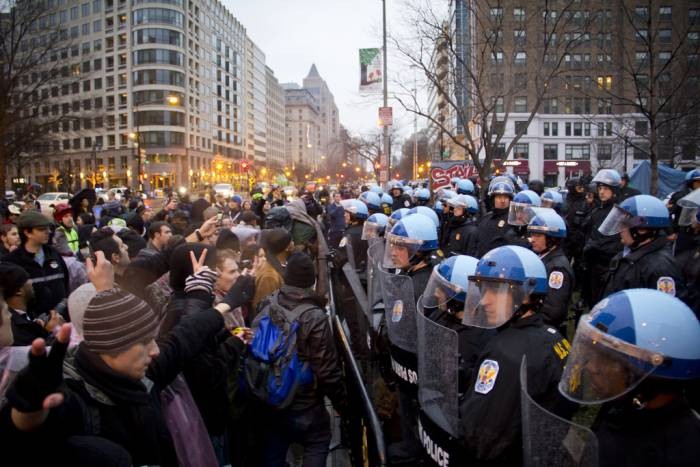 Image: Flickr, thisisbossi
Image: Flickr, thisisbossi
In fact these have already begun. Immediately after the election of Trump there were mass demonstrations in every city. The Women’s March was the largest single-day protest in American history. That was on the weekend he was inaugurated. And that was only the beginning of what is yet to come.
The reason why the ruling class hates Trump is because he has delivered a crippling blow to the already worn-out consensus that existed between Democrats and Republicans. Undermining that consensus could lead to very dangerous consequences, as seen in the recent government shutdown. The collapse of the so-called political centre reflects the widening abyss and sharp polarisation between the classes in US society. That has the most serious implications for the future.
Obama and the Democrats are responsible for the victory of Donald Trump. But Trump is himself deepening the process of social and political radicalisation, preparing an even bigger swing to the left. In a serious condemnation of the two-party system, the latest polls show that a record 61% of Americans are opposed to both the Democrats and Republicans and believe a new major party is needed. Among the youth, the figure is 71%. This polarisation in the US – to both the left and the right – has produced the phenomenon of the sudden growth of the DSA, Democratic Socialists of America, a left group historically on the fringes of the Democratic Party.
Before the Sanders campaign this group had about 6,000 members: mainly old timers, imbued with a thoroughly reformist outlook. But since the election of Trump, DSA has ballooned to over 30,000 members, mostly youth looking for a socialist organisation. They have broken into many new areas where previously they had nothing and are developing a base on many campuses across the United States. There is now an internal debate on whether to break entirely with the Democrats. Some layers are developing very radical ideas and are wide open to the ideas of revolutionary Marxism. The future of this organisation has yet to be determined, but if it breaks with the Democrats and adopts a class-independent position, it has the potential to play an important role in the eventual creation of a mass socialist party in the US.
Canada and Quebec
Canada was not as hard hit by the 2008 crisis, as it had less of a housing bubble and the economy was propped up by resource exports to a booming China. Consequently, Canada has not felt the same degree of austerity as other OECD countries. However, the factors leading to stability are turning into their opposite. Cheap credit has fuelled debt and an explosion in the cost of housing. Household debt is at an unprecedented 171% of annual income and climbing. China is no longer pushing up oil and mineral prices to the same degree, while Trump’s protectionist threat to pull out of NAFTA threatens Canadian exports. A new global economic downturn would precipitate all these contradictions.
Quebec, however, has seen a period of intense class struggle, starting with the 2012 Quebec student strike. Unfortunately, due to a combination of ultra-leftism from a section of the student leadership, and opportunist capitulation by the union bureaucracy, the movement has subsided, but the active layers are searching for answers.
Quebec nationalism is in crisis. The Parti Quebecois has moved to the right and adopted a racist nationalism. The PQ has been in government and enacted austerity many times in the last 40 years, which explains why the youth see it as part of the establishment. The left nationalist Quebec Solidaire could act as a conduit for the discontent, but its petit bourgeois leadership is confused and makes many mistakes. Typically, when they focus on class issues they gain support, but when they focus on independence they become identified with the PQ.
There is no enthusiasm for new independence referenda amongst class conscious workers and youth. While we should not discount the possibility of the class anger of the masses expressing itself through a national independence movement, this seems to be an unlikely perspective for Quebec in the near-term.
China
The Chinese economy has experienced a huge development of the productive forces in the last 40 years. That was one of the main things that kept the world economy from falling into a deep slump, keeping it afloat for 20 to 30 years. But now that has reached its limits. Growth in China has sharply decreased and is now less than 7%. That is very low by Chinese standards.
There are many unsolved contradictions in the Chinese economy. China’s manufacturing is heavily dependent on exports. In order to maintain the rate of growth China must export. If Europe and America are not consuming as they have in the past, China cannot produce as it did in the past because they need foreign markets to absorb their surplus product. And if China is not producing, then other countries like Brazil, Argentina, Canada and Australia cannot export their raw materials. Thus globalisation manifests itself as a global crisis of the capitalist system.
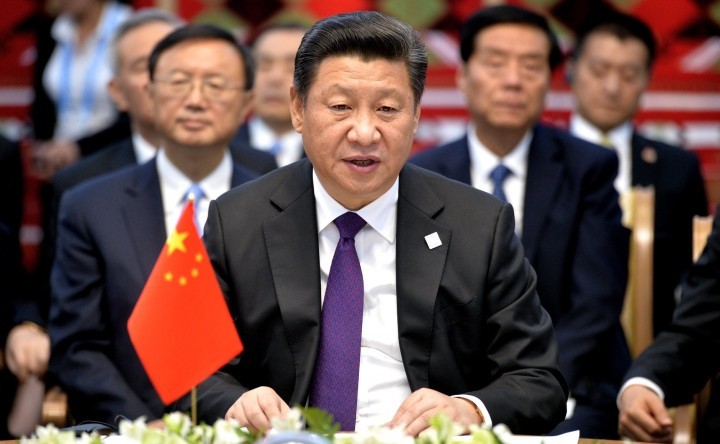 Image: kremlin.ru
Image: kremlin.ru
In the aftermath of the global financial crisis, China’s rulers were alarmed. They estimated they needed to sustain a minimum annual growth rate of 8% to prevent an accumulation of unrest that could threaten their rule. They resorted to Keynesian policies and launched an unprecedented plan of new public investment in infrastructure. They used the state-owned banking system to launch the greatest example of monetary easing in history, offering easy loans. But this creates new contradictions that threaten the future stability of China and the entire world.
As a result, Chinese government debt to GDP has doubled since 2008, at 46.2%, although it is still relatively low compared to that of the USA. However, total debt (the combined state, bank, business and household debt) has grown exponentially and threatens to spiral out of control. In absolute terms, China’s total debt ballooned from about $6 trillion at the time of the 2008 financial crisis to nearly $28 trillion by the end of 2016. As a percentage of GDP, total debt has risen from 140% to almost 260% over the same period. And the official figures undoubtedly understate the real situation.
It is likely that China’s total debt is nearer to 300% of GDP – and this estimate does not include the unregulated sector of shadow banking (estimated to be worth between 30 and 80% of GDP), which the World Bank in its October 2017 report on the East Asian and Pacific economies specifically warns is one of the greatest threats to regional prosperity.
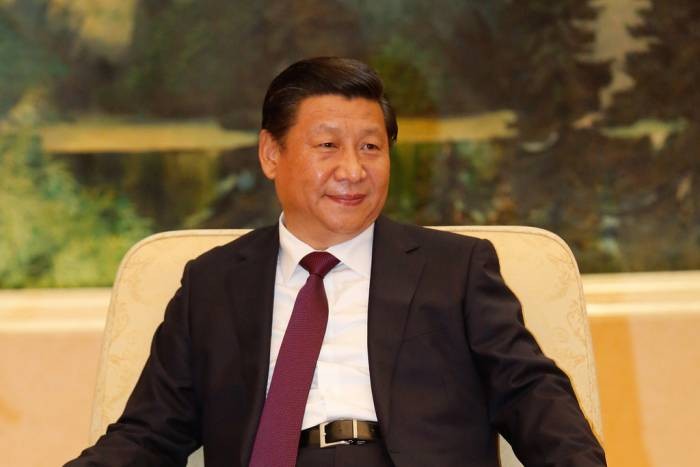 Image: Flickr, theglobalpanorama
Image: Flickr, theglobalpanorama
The Chinese economy was undoubtedly saved in the short term by the government’s decision to open the credit floodgates, but that has resulted in an economy dependent on borrowing and afflicted with huge asset bubbles. The real test will come when Beijing eventually attempts to reduce this debt dependence. This can trigger a financial collapse, which the serious bourgeois economists fear would have a devastating effect on the world economy. Last year, the International Monetary Fund issued a warning about Beijing’s reluctance to rein in dangerous levels of debt.
At this moment in time a collapse of the Chinese finance system does not appear imminent. But neither did the crash of 2008 appear imminent…before it happened. It is true that because of the specific weight of the state sector, the Chinese government can exercise more control over both borrowers and lenders than would be possible in a normal market economy. It can order state-owned banks to keep lending to loss making companies or to smaller lenders that rely on short-term credit to stay liquid. As of the end of December 2017, China holds $3.14 trillion in foreign currency reserves, which can be used for “emergencies” – but even this will not save them forever.
This has allowed Beijing to delay problems much longer. But to delay a problem does not mean that it is solved. On the contrary, the longer the present unsound position is allowed to continue, the more violent and convulsive the crisis will be when it comes – and sooner or later, come it must. The slowing of the economy has led to a big increase in unemployment which is concealed by official figures, which do not include the millions of migrants who come from the countryside because they cannot find work. This will affect the political and social situation.
It is hard to know with precision what is happening in China. In a totalitarian state the news is strictly controlled. But there have been widespread strikes and demonstrations: the number of such “incidents” doubled every year between 2011 and 2015, and this was only the tip of the iceberg. The regime managed to halt the wave of strikes by putting pressure on companies not paying wages on time and by prosecuting enough cases of corruption to appear to some to be “on the side of the workers”.
Under the apparent calm on the surface there is huge anger building up. The indignation of the masses is being stoked by injustice: the arbitrary actions of the bureaucracy with peasants having their lands stolen by corrupt officials, the destruction of the environment, with Beijing and other cities shrouded in toxic clouds, and above all the scandalous inequality that openly mocks the claim that China is a socialist country.
The Chinese workers could put up with these things as long as they felt that somehow things were advancing and the situation was getting better. But they are finding that this is no longer the case. The destiny of China depends on the future of the world market. China benefited from its participation in the world market, but now all the contradictions are coming back to hit them. An explosive situation is building up that can burst onto the surface without any warning.
Australia and New Zealand
Both Australia and New Zealand escaped lightly from the 2008 global financial crisis and recession. Australia avoided a recession from 2008 onwards, on the one hand due to the minerals and aggregates boom (exported mainly to China). To date Australia has had a historic 26 years without a recession.
This economic growth has been maintained at the expense of the working class. Australian workers have experienced stagnant wages, under-employment and attacks to the social wage from successive governments e.g. real term cuts to health care and raising the state pension age. Insecurity and casualisation is rising, particularly among the youth. This is one of the reasons why 58% of Australian 22-38-year olds view socialism favourably, 59% think capitalism has failed and 62% think that workers are worse off today than 40 years ago.
In New Zealand, the election of a Labour led government was a political earthquake. Jacinda Ardern with her Corbynesque campaign turned around a certain defeat to a victory. At the start of the year Labour was polling 24%. With a shift to the left, Labour received 37% in the election but then went on to form a coalition with a right-wing populist party (New Zealand First) and the Greens. Ardern tapped into a mood of discontentment in the masses who have had nine years of austerity under the National Party, despite a growing economy.
The masses are expecting a lot from the government, even if its programme lacked any attempt at a socialist manifesto. Workers feel emboldened by the new government. Already teachers, nurses, railway and dock workers are threatening to or taking strike action. Minor reforms have been granted such as increased welfare payments, one year’s free university fees, and halting the increase in the pension age, but this is reaching the limit of the capitalist system. The signing of the TPPA shows the real direction that the government is travelling.
World relations
The conflict with North Korea glaringly exposed the limits of the power of American imperialism. Trump threatened it with total destruction, but that did not provoke a backtracking on the part of North Korea and only led to the bellicose noises and add to the growing number of nuclear tests and rockets flying over Japan.
The US was considering installing a missile base in South Korea, which the Chinese adamantly oppose. Trump was compelled to eat his words and seek the support of Beijing to put pressure on Pyongyang. China has, in fact, been applying gentle pressure of its own on the North Korean regime to push it in the direction it desires, to rein it in in order to avoid a more open and dangerous conflict with the US. This is far from what Trump wants. But China’s bottom line on North Korea is that it is not going to allow a chaotic collapse of the regime. In addition, the bureaucracy of North Korea, which relies on China, does not intend to end up like Saddam Hussein or Gaddafi.
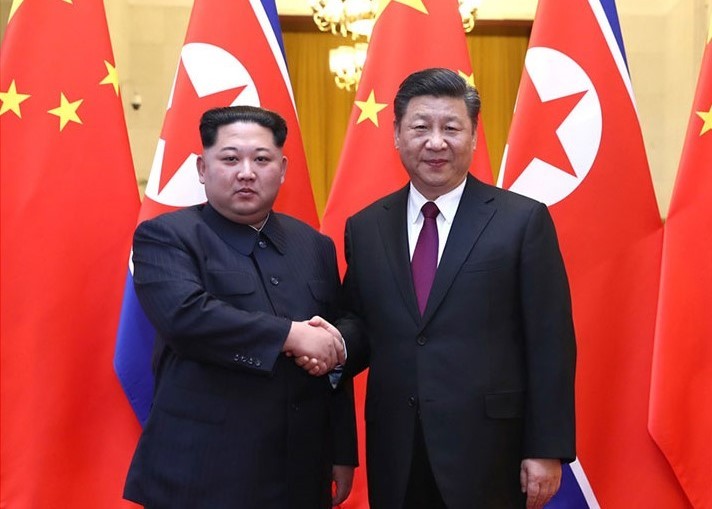 Image: 中华人民共和国国务院
Image: 中华人民共和国国务院
Obviously, Trump’s international performance and his threats and bravado should be understood as his quest to reaffirm an international position for the United States in a chaotic economic and political situation on a global scale. His pressure and rhetoric on North Korea aims, on the one hand, to sidestep and cloud the internal environment in the United States, increasingly adverse to his policies and methods, as well as to push to negotiate and move forward in the nuclear disarmament of any country that the US considers “unreliable” or an “enemy”, be it Korea, Iran, etc.
In the current international situation of crisis, the US, despite remaining the world's most powerful economy, has neither the conditions nor the interest to shell out huge sums to “help” allies. This is provoking a global search for a realignment of several regimes in crisis with whoever can do this in one way or another, and China has a lot of idle capital. Duterte, the Philippine “strongman” said that the US talks a lot but won’t do anything. He has drawn the conclusion that he would gain more and dragged the Philippines towards China’s orbit. South Korea is now closer to China diplomatically, especially because of its historic tensions with Japan.
Thailand used to be one of the closest allies of the US, but it announced that it would buy submarines from China, which also implies cooperation with China. The plan was put on hold because of American pressure, but it seems it will go ahead. The 2014 coup in Thailand was condemned by the US, but praised by China. Vietnam and Malaysia have also forged closer economic ties to China, although relations between China and Vietnam are complicated by territorial conflicts, especially over China’s claims in the South China Sea.
China and America are engaged in a struggle for markets and influence. Many countries have China as their number one trading partner. It has stakes in two thirds of the 50 most important ports in the world. Its One Belt One Road project is the biggest diplomatic and financial project since the Marshall Plan.
The tensions between the two powers are at their sharpest in the region of the South China Sea, where the Chinese ruling class has developed its own version of the Monroe doctrine, meaning that it must have control over its own backyard. China’s provocative “island-building” projects are opposed by Washington, which has sent warships to assert what it calls the “freedom of the seas”.
Before the Second World War the tensions between the US and China would have already led to war. But nuclear-armed China is no longer the weak semi-colonial country of the past and there can be absolutely no question of America invading and enslaving China today.
The Middle East
In the Middle East the contradictions of world capitalism are exposed in concentrated form. The crisis of world capitalism is also the crisis of US imperialism. When the ignorant and incompetent American imperialists stormed into Iraq and wrecked the whole country, they not only destroyed the lives of millions, but by destroying the Iraqi army they also disrupted the fragile equilibrium between the powers in the Middle East. All the subsequent crimes and monstrosities are ultimately due to this monstrous crime of imperialism.
With the elimination of the Iraqi army, Iran’s influence grew rapidly to the detriment of the US and its traditional allies, in particular Saudi Arabia. The bloody conflict in Syria, which was really a proxy war between several foreign powers, was an attempt to claw back lost ground. It aimed at isolating Lebanon and taking Syria out of the Iranian sphere of influence. But today, Iran’s influence is stronger than ever in Syria or Lebanon.
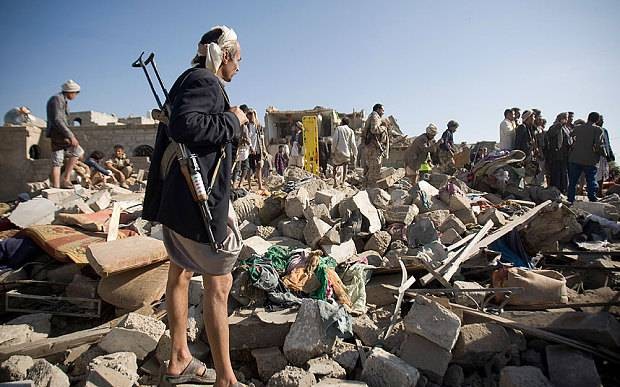 Image: public domain
Image: public domain
In Syria the limits of the power of US imperialism are glaringly clear. The most powerful nation on earth is unable to intervene militarily in a decisive manner. This left a vacuum into which stepped Iran, Russia and Turkey. The Russian intervention decisively tipped the balance in Assad’s favour. The fall of Aleppo marked a decisive turning point and a devastating and humiliating defeat – not just for the USA, but also for its allies, especially Saudi Arabia.
Now ISIS has been defeated in both Syria and Iraq. But the root problem has not been solved. What will happen now? The Turks are watching Raqqa, Mosul and even Kirkuk like hawks, waiting to grab what they can. The Iranians have increased their influence throughout the whole area, to the alarm of the Americans, Saudis and Israel. Meanwhile Iraq and Syria have fragmented and will remain unstable through the next period.
One section of the US ruling class wanted to continue the war, but this attempt was doomed to failure. Putin outmanoeuvred them at every step. When the Russians called a peace conference in Astana, Kazakhstan (a client state of Russia) the Americans and Europeans were not even invited. In the end, despite all the public rhetoric, the Americans were reluctantly obliged to accept the fait accompli dictated by Moscow.
The plain fact is that the US has been defeated in Syria. It reflects a shift in the balance of forces in the region. This will have far reaching consequences, in particular amongst Washington’s allies who have lost confidence in the US and have increasingly been following their own paths and interests. Turkey is supposed to be an ally of the United States and is a key member of NATO but increasingly, the Turks and the US have found themselves backing opposing forces in Syria.
Initially, the US placed its bets on the Turkish and Saudi backed Jihadi rebels, but these proved inefficient and – as became clear with the rise of ISIS – unreliable defenders of US interests. The Pentagon was therefore obliged to throw its weight behind the Kurdish YPG forces in the fight against ISIS in Northern Syria.
But there is a problem. Erdogan has big ambitions in the region. He wants an Ottoman-style empire and the Kurds form a physical and political obstacle for him. His main interest now is to crush the Kurds, both in Turkey and Syria. Defeated in Syria, Erdogan decided to change course, leaning on Iran and Russia in order to gain leverage to manoeuvre with the West.
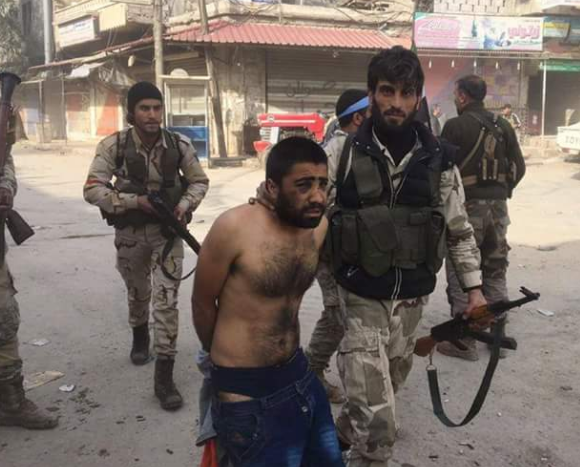 Image: fair use
Image: fair use
In effect, by ditching the rebels in Aleppo and elsewhere, who are backed by the US, Saudi Arabia and other Gulf States, Russia and Iran allowed Turkey to take a slice of Northern Syria to stop the Kurdish forces from expanding their territory there. This cooperation of Turkey, Russia and Iran has dealt a shattering blow to the Americans and Saudis, whose Jihadi stooges have been crushed or forced to conform to the Astana deal, though the increased weight of the astute Erdogan in the region will only lead to further intrigues and uncertainty.
Trump’s plan to undermine the Iran nuclear deal is a desperate attempt to turn the clock back. But whereas the US is under constant pressure to pull its forces out of the Middle East, Iran commands hundreds of thousands of battle hardened militiamen entrenched in Iraq, Syria and Lebanon. In the final analysis, that will be the decisive factor. The Europeans have disassociated themselves from Trump’s policy over Iran, which turns out to be more to the detriment of Washington than Teheran, which is enjoying the spectacle of disarray in the West.
Saudi Arabia
Saudi Arabia threw billions of dollars into the most reactionary groups in Syria. But it has lost. The Saudi war on Yemen is also failing. After almost three years of brutal fighting, which has wrecked the whole country and left millions facing starvation, the Iranian backed Houthis have a strong position in their areas. Meanwhile the Saudi coalition has all but fallen apart. The Jihadi, South-Yemen nationalist and Emirati troops composing the Saudi backed forces are all following their own agenda. This is yet another defeat which will further undermine the foundations of the rotten Saudi regime.
The Saudis tried to assert themselves in Qatar, by demanding that it cut its ties with Iran and Turkey and fall in line with Saudi foreign policy. But Qatar merely strengthened its trade and military ties with Iran and Turkey. Turkey has expanded its military base on the peninsula – a serious warning to the Al-Sauds not to go too far. Trump originally threw his weight behind the Saudis until he was quietly informed by his advisors that the US has a very important military base in Qatar.
The old king Abdullah was a hardened reactionary, but he was cunning and cautious. The new regime, led by upstart crown prince Muhammad Bin Salman, is anything but cautious. Like a losing gambler he is frantically indulging in risky bets to counter Iran’s expanding power and influence. But these efforts, far from halting the process of Saudi decline, are accelerating it and giving it an even more convulsive character.
 Image: Mazen Al Darrab
Image: Mazen Al Darrab
For decades the life of this reactionary regime was artificially extended by imperialism due to the particular role it played as a main supplier of oil for the US and as the main base of counter-revolution in the Muslim world. Coupled with the high oil prices, the regime could maintain itself by buying off the reactionary tribal and religious layers that form its base.
But today these factors are disappearing. The US has become less dependent on oil imports due the increase in its own production of non-conventional hydrocarbons (in 2016 its production was just over 12 million barrels a day, with a consumption of 19 million; while in 2008 the figure had been more or less half, 6 million, and consumption was over 20 million). In this sense, Saudi Arabia has to search for other buyers of its production, such as China. The role of the Kingdom in world relations has declined and thus the interests of Saudi Arabia and the US ruling class have begun to diverge. The crisis is also eating into Saudi reserves, forcing them to implement austerity for the first time ever. They can no longer buy social stability by bribing the local population with lavish subsidies and guaranteed jobs in the public sector.
In the medium term all these factors will combine to undermine the stability of the regime, which can fall like a rotten apple when least expected. Whatever replaces it will not be to the liking of Washington. Under the impact of the crisis of US imperialism, the old order in the region that was set up by British and US imperialism is unravelling.
As if all this were not more than sufficient, the brazen stupidity of Trump in recognizing Jerusalem as the capital of Israel and moving the US embassy from Tel Aviv was aimed at a US audience, but it has added a new element of explosive instability for the Middle East. It has also caused further divisions between the European and American imperialists. The former fear the consequences for the so-called peace talks, which in any case nobody took seriously, if they ever did. The latter, as usual, understood nothing and foresaw nothing.
However, it seems unthinkable that Trump could have taken that decision without the knowledge and tacit consent of the Saudi leaders. They are now firmly aligned with Trump and the Israelis and are mainly concerned with confronting Iran. They will have agreed to stab the Palestinians in the back while making a few obligatory noises in order to play to the Arab gallery. That will eventually prove to be one more nail in the coffin of the corrupt and despicable Saudi regime.
Revolution in the Middle East and North Africa
The revolution, which swept through the region in 2011-2013, failed because it lacked a revolutionary leadership. Today the general movement, tired and confused, has retreated and left room for reaction to manoeuvre. The rise of reaction and Islamist counter-revolution throughout the region is connected to the ebb in the revolutionary movement.
However, the events of 2017 in Morocco show that the revolution is not dead. The uprising in the Rif was the most spectacular movement in Morocco since the 2011 revolution in the Middle East and North Africa. The immediate incident that launched the uprising was the killing by the police of a young fishmonger in a rubbish truck. Once it began, this movement unfolded with incredible speed and intensity. A nationwide solidarity movement of the working class and the oppressed layers sprang into life with its own demands, which were neither nationalist nor sectarian.
This movement anticipates developments in the rest of the region, where not a single stable regime exists. All of the regimes in the region are weak and fighting for their survival. They cannot solve any of the problems of the masses who in turn are under enormous pressure. Sooner or later the movement will revive on an even higher level.
World war?
The crisis over North Korea’s nuclear programme caused a lot of talk of a world war. But this is premature to say the least. Under present conditions world war is completely ruled out by the class balance of forces on a world scale. The imperialists do not make war for arbitrary reasons. The bourgeoisie resorts to war in order to conquer markets and spheres of influence. But war is a very costly and risky business. And with nuclear weapons the risks are multiplied a thousand fold.
Russia is not militarily as strong as America, but it is a very powerful military state. And it is far stronger militarily than British, French or German imperialism, both in conventional and nuclear terms. The West could do nothing to prevent it taking over Crimea (where the majority are Russians anyway). Nor could it do anything to prevent Russia from intervening to save the Assad regime in Syria. These two cases reveal the limitations of US imperialism’s power.
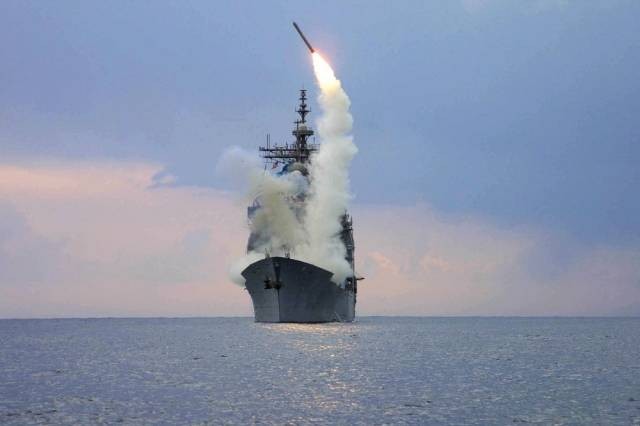 Image: fair use
Image: fair use
Last year NATO sent a few thousand troops to Poland as a warning to Russia. That was just a joke. The Russians replied by holding the biggest ever military manoeuvres together with Belarus on the very border of Poland. That was a little warning to NATO. From a military point of view, compared with Russia, Britain nowadays is almost insignificant, France is not much more, Germany is nothing at all.
Above all, the international class balance of forces is a serious barrier to the launching of a major war. It should be remembered that before the Second World War could take place, the working class had to first suffer a whole series of crushing defeats in Hungary, Italy, Germany, Spain… But now the forces of the working class are intact. The working class has not suffered any serious defeats in the advanced capitalist countries.
In the USA the people are tired of military adventures. US imperialism burned its fingers badly in Iraq and Afghanistan. It cost them an enormous amount of blood and treasure without achieving anything. As a result, Obama was not even able to order a military intervention in Syria. He tried but he saw that it would have provoked a massive popular revolt. He had to back down. The same was true of Cameron's Conservative government in Britain.
There cannot be a world war at least for the foreseeable future, unless a totalitarian regime came to power in the US on the basis of a crushing defeat of the American working class. That would be a qualitatively different balance of forces. But that is not the position in the immediate future. On the contrary, for a whole period the pendulum will swing to the left.
Trump is a reactionary bourgeois politician, but contrary to the demagogic assertions of some on the Left, he is not a fascist and does not stand at the head of a totalitarian state like that of Hitler. On the contrary, he does not control the state at all: it is at war with him. He does not even have total control of Congress, although it is dominated by the Republican Party. In fact, his hold on power is extremely tenuous. The Strong Man in the White House has feet of clay.
Although a war on the lines of 1914-18 and 1939-45 is ruled out under present conditions, there will be constant small wars all the time which under modern conditions are frightful enough. Iraq was a small war. Syria was a small war. The civil war in the Congo cost the lives of at least five million people and did not even make the front pages of the newspapers. This kind of thing will occur again an again. Meanwhile, the spread of terrorism means that this barbarism is beginning to affect “civilised” Europe. This is what Lenin meant when he said that capitalism is horror without end.
America and Europe
The people who really control the EU are the bankers, bureaucrats and capitalists, and particularly German capitalism. Originally the EU was dominated by France and Germany. The French bourgeoisie had big ideas that they could dominate it politically and militarily and Germany could dominate it economically. That didn’t last very long. Nobody now doubts that it is the German ruling class that dominates it completely.
As a result it has immediately come into conflict with the new man in the White House. Donald Trump and Angela Merkel are not on good terms. The reason is not to be found in their personal attributes – although these are very different. It is rather to be found in Mr. Trump’s electoral slogan “Make America Great Again.”
For the moment the German capitalists are doing rather well, with a huge trade surplus. In 2016, it was in the region of $270bn: an all-time record high. It is not necessary to be a Nobel Prize winner in economics to know that one country’s surplus is another’s deficit. Trump can at least add up and is not at all happy with this figure. And since diplomacy is not really his strong point, he has said so publicly to Merkel.
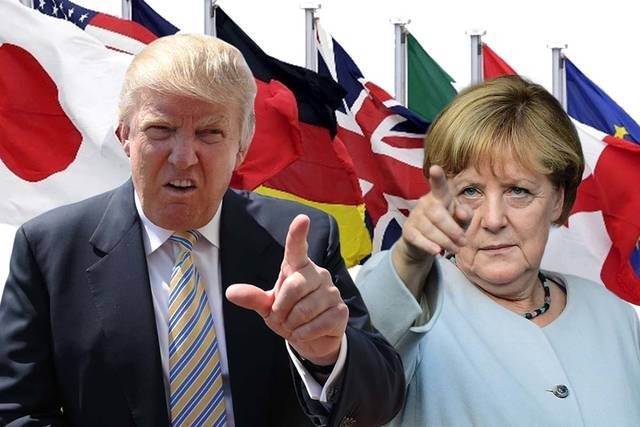 Image: Socialist Appeal
Image: Socialist Appeal
Trump says: “If the Germans don’t do something, I will cut the import of German cars into the U.S.” Now, this is very dangerous talk. If he continues down that road, that is a recipe for a trade war. The Germans would immediately retaliate, blocking certain American goods. Protectionism is the export of unemployment. Trump says he wants more jobs in America for Americans, which means fewer jobs for Germans, Chinese and others. That is the root cause of the antagonism between Washington and Berlin.
Trump went to Poland, where he met with an enthusiastic response. The choice of this visit was not at all accidental. Relations between Poland and Germany have been strained for a number of reasons, particularly over the question of imposing quotas for refugees. In fact, the fault lines in Europe are deepening all the time. The problem with Europe is that the European countries don’t agree on anything very much these days. That is why Mr. Trump went to Poland: to deepen the cracks between Germany and its eastern neighbour.
His next stop was Paris, and that was also not accidental. Trump wants to drive a wedge between France and Germany. For his part, Macron was pleased to receive him to encourage the Americans to put pressure on the Germans, who already have enough on their plate with the negotiations over Brexit. That explains why Trump is so keen to express his solidarity with London, holding out the tempting prospect of a trade deal, sometime in the future – which may, or (very likely) may not, materialise.
Europe
The bourgeois economists are empirical and impressionistic. They detect a very slight growth in Europe – just over one percent (rather more in Germany) and they joyfully proclaim that the euro crisis is resolved. But the euro crisis is not resolved. In reality the crisis of European capitalism continues to deepen. In spite of the small upturn, the underlying fundamental problems remain. Nothing has been solved.
The economic experts of the IMF are publishing alarming reports about the state of the banks in Europe. The ECB has ploughed in billions, but as a result, when the next crisis comes, as it will as night follows day, it may lead to the collapse of the euro and possibly even threaten the unity of the EU itself. On 3 June 2017 The Economist stated: “The currency changed from an instrument for convergence between countries to a wedge driving them apart.” These few words show how the intelligent bourgeois are grasping what the Marxists said long ago.
Added to the already unstable situation within the EU is the refugee crisis. The imperialist meddling in the Middle East and North Africa has opened the gates to a flood of humanity desperate to escape the living hell it has been plunged into. This is putting enormous pressure on the EU member states, especially those most exposed to the daily arrival of new refugees and migrants.
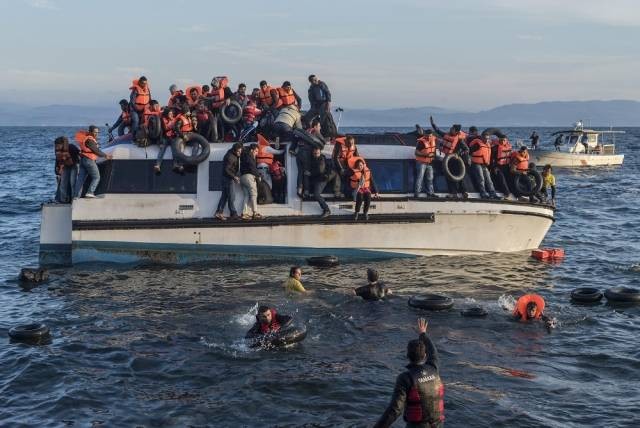 Image: public domain
Image: public domain
Europe is thoroughly divided on this issue. Poland, Hungary, Slovakia and the Czech Republic are refusing to take any refugees. The problem is further exacerbated by the internal migration from the poorer EU countries to the richer ones, which in turn is provoking tensions even in a country like Germany, where the right wing is riding on the refugee question to win a section of the electorate.
This is in complete contrast to the situation after 1945, when Germany absorbed a far bigger influx of refugees from Eastern Europe. That was in a situation of world capitalist upswing. But in a situation of deep economic crisis and the stagnation of the productive forces, the influx of refugees only serves to create new contradictions that cannot be solved on the basis of capitalism. This is yet another factor of instability, increasing the centrifugal tendencies within the EU.
Germany is an economic giant but its Achilles’ heel is its dependence on exports. “Poor old Germany. Too big for Europe, too small for the world”, as Henry Kissinger put it. German capitalism is highly dependent on exports to the EU and the whole world and thus very vulnerable for future trade wars and world recessions. The reports about an alleged German “job miracle” conceal the fact that the price has been a huge casualisation of labour. Already, 40% of the population have lower living standards than 20 years ago. A shortage of affordable housing, a growing layer of “working poor” and pensions below the poverty line for millions will provide a material basis for enormous unrest, explosions and a new chapter of the class struggle in Germany. With their policy of counter-reforms the Social Democrats (SPD) have lost half of their electorate and membership over the last 20 years. The political instability and beginning of a new epoch was expressed by the fact that it took nearly six months to form a new government after the 2017 elections.
Brexit
The tendencies towards the breakup of the EU also expressed themselves dramatically in Brexit. The vote in the referendum was yet another example of the mood of anger and bitterness that exists everywhere beneath the surface. The result was a political earthquake.
The bourgeois commentators were stunned when the “Leave” vote won. And those who were most shocked were the advocates of Brexit themselves. They never imagined they could win, and therefore had no plan and no strategy. Even now they do not appear to have the slightest idea what they are doing. The decisive sections of the British bourgeoisie did not want to leave the EU, but were forced to accept the result of the referendum, which will be disastrous for British capitalism and will also cause serious problems for the EU itself.
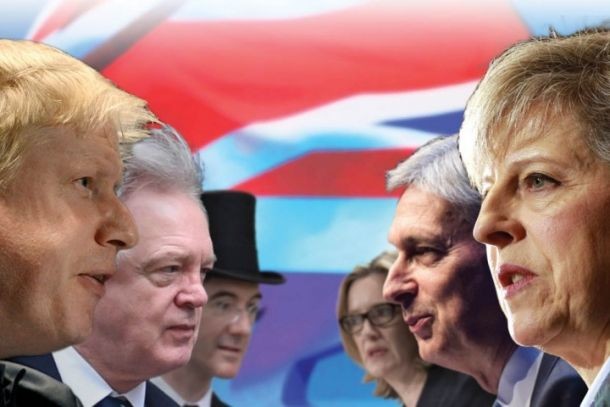 Image: Socialist Appeal
Image: Socialist Appeal
Brexit has created very serious problems in Ireland. The border between the independent south and the north, which is part of the UK, was made practically irrelevant in recent years. If the border is reintroduced when Britain leaves the EU it would have a devastating economic impact on both the south and the north. As a result the whole Irish national question could be revived with the most serious implications. The politicians are struggling to reach some kind of a deal over this complicated question. Whether the end result will be sufficient to square the circle remains to be seen.
The British imagined they would have an easy ride. But that was never going to be the case. Even if Merkel wanted to be nice to the Brits (which is not at all clear), she cannot do London any favours because that would encourage others to follow its example and leave. To complicate things further, Merkel suffered a defeat in the elections and has the nationalist and anti-EU Alternative für Deutschland (AfD) breathing down her neck. All the fine talk about “European solidarity” is instantly forgotten, as the national antagonisms come to the surface. The outcome will create big problems both for Britain and the EU.
Greece
In Capital Marx explains that during a boom, credit is easy but when there is a crisis all that changes into its opposite. The modern day Shylocks are demanding their pound of flesh from the Greeks. But there is no way that Greece can ever pay what Berlin and Brussels are demanding. All this has consequences. They are whipping up immense class hatred and polarisation in Greece and in all countries of Southern Europe.
After a decade of indescribable suffering, austerity, poverty and misery, what has been solved in Greece? The nation has been plunged into a desperate crisis. The young people have no work and are driven to emigrate, while the old are deprived of their pensions and driven to commit suicide.
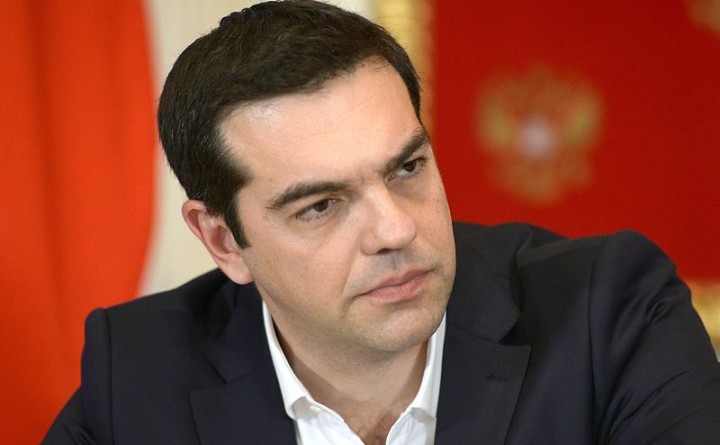 Image: Пресс служба Президента России
Image: Пресс служба Президента России
Revolution is not a straight line, there will inevitably be ups and downs that we must be prepared for. After so many years of strikes, protests and demonstrations the Greek workers are exhausted and disappointed. They will say: “Everyone betrays us. We trusted Pasok, but Pasok betrayed us. We trusted Tsipras, and he also betrayed us – What more can we do?” In the next general election SYRIZA will do badly according to opinion polls, falling to around 20% or even less. The Communist Party may make some small gains, but will not be able to fill the vacuum left by SYRIZA due to its sectarian stance. By default the New Democracy stands to gain, not in terms of any significant swing towards it, but simply in percentage terms. This would mean a right-wing coalition centred on ND would come to power. This would be a weak unstable government, but it would be forced to continue and deepen the attacks on the working class without having any authority with the working class. In these conditions there would be a renewed radicalisation to the left.
The present moods will not last forever; they are of a transitory character. The depth of the crisis is such that the workers and the youth have no alternative but to return to the struggle. New and even more violent explosions are being prepared for the future.
France, the bankruptcy of Macron’s “Centre”
French capitalism was in crisis long before 2008. But last year’s elections in France provided the European bourgeois with an apparent respite. They were terrified that Marine Le Pen would come to power, as Trump had done in the USA. Like Trump, Le Pen is a reactionary chauvinist. She is also hostile to the European Union, and that, especially following the Brexit debacle, provoked serious concern in Brussels and Berlin. What really terrified the French bourgeois was the sudden surge of Mélenchon in the polls, at the very end of the campaign, because he would have certainly won against Le Pen or even Fillon in the second round – and had some chances to win against Macron.
The rise of Mélenchon shows that there is a growing polarisation between left and right. Jean-Luc Mélenchon came close to beating Le Pen, and he could have done so except for the sectarianism of the so-called Trotskyists in France. In the concrete conditions of these elections, the votes received by NPA and LO could have made the difference between Mélenchon or Le Pen standing in the second round.
A direct clash between Mélenchon versus Macron in the second round would have changed everything. But that was prevented by the splitting antics of the sects. It would have been entirely possible for them to begin a campaign with a revolutionary programme, and then withdraw in favour of a vote for Mélenchon. They didn’t do that because they are typical sectarians who place the interests of their own petty sects before the general interests of the French working class.
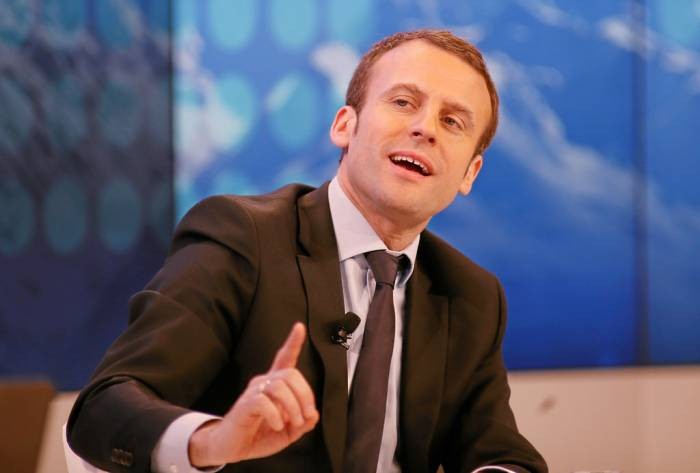 Image: WEF
Image: WEF
In the end Macron won, and the bourgeois breathed a sigh of relief. The extremes were defeated and Moderation had triumphed at last! The good news sped from Paris to Berlin, to Rome, even in London they were opening bottles of champagne in the City. The Centre had won, but what do these people mean by Centre? They mean the Right that disguises its true nature by posing as something that it is not.
Macron has risen to power on the basis of the disintegration of the two parties that traditionally had the majority of voters (the Socialists and Republicans). In these elections the Socialists were crushed and the Republicans also lost heavily and did not reach the second round of the Presidential election. The PS may end up like the Pasok in Greece. The right-wing Republicans are also in very bad shape: prominent leaders have left the party to join Macron's government (or party); the others are split in different fractions.
The Communist Party has been compromised by its links to the discredited Socialists and is now a marginal element in French politics. On the other hand, the Front National, despite its electoral defeat, won 1.3 million more votes than in 2012. But La France Insoumise, the party of Mélenchon, won 3 million votes and is now, together with the unions, the main opposition to Macron’s policies. In an opinion poll in October, 35% put La France Insoumise as the main opposition party, 13% pointed to the Front National and only 2% to the PS and the CP! Mélenchon’s party is now the main opposition both in parliament and on the streets.
 Image: wikicommons
Image: wikicommons
It is not true that Macron won by an absolute majority. The absolute majority – including those who cast blank votes or abstained – did not vote for Macron! And this “silent majority” will not be silent for long. In fact, it did not take long for Macron to expose himself, since he immediately confirmed his intention to change the labour law to make it easier to sack workers.
Marx said that France was the country where the class struggle is always fought to the finish. The truth of that statement will soon be clear to everybody. We will see big demonstrations, strikes and general strikes. A repetition of 1968 is not at all ruled out: in fact, it is implicit in the situation.
Italy
Greece was the weakest link of European capitalism. Spain is only one step behind Greece. Italy is only one step behind Spain. And France is one step behind Italy. The Italian economy has been stagnating since the hard economic blow of 2008. Consequently scores of small and medium businesses have gone insolvent leaving them unable to pay back their debts.
The European banking system is in a disastrous state. It is weighed down with debt, and is only being propped up by the European Central Bank (ECB). That cannot continue indefinitely, since the ECB is being underwritten by the Germans. And they are not prepared to finance the deficits of the countries of southern Europe through their contributions to the ECB.
In Italy, there has been a major banking crisis. The fact is that the Italian banks are mainly bankrupt. According to EU rules governments are not allowed to bail out banks, but Italy was an exception. If the Italian banking system collapses it could bring down the whole European financial system. But the illegal bailouts solved nothing fundamental. Italy is in a deep crisis – not just economically and financially but politically.
There is a collapse of confidence in political parties. This was revealed clearly in the December 2016 referendum on constitutional reform where Renzi was massively defeated. The problem of the Italian bourgeois is that they do not have a strong government. But how can they get a strong government when they don’t even have a strong party? They used to have the Christian Democracy, but that is finished. Berlusconi’s Forza Italia is also weakened. And the Democratic Party (PD), a bourgeois party formed from fusing a section of the old Communist Party with what was left of the Christian Democracy and other small bourgeois organisations, is in decline.
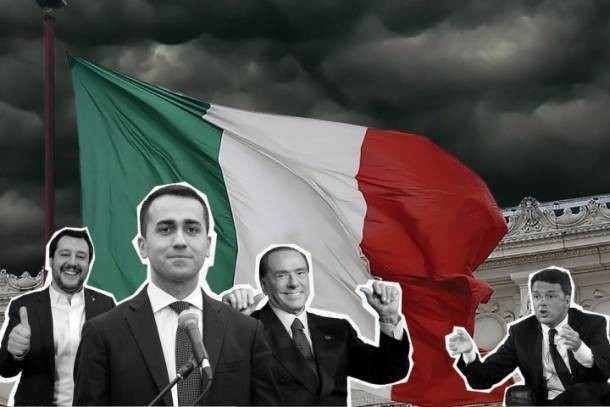 Image: Socialist Appeal
Image: Socialist Appeal
There is a process of complete fragmentation of the so-called Left which, put together don’t even reach seven percent in the opinion polls. In the past the Italian ruling class could rely on the PCI leaders to hold back the working class. But as a result of decades of Stalinist degeneration and numerous betrayals of the working class, the once all-powerful Communist Party has been totally liquidated.
In this vacuum we have seen the rise of Beppe Grillo and his Five Stars Movement (M5S). This is a protest movement, mainly petit-bourgeois in composition, with a confused mishmash of policies – some of them reactionary in character. In fact, it is not a party at all, and doesn’t have a structure. The 5 Stars have often resorted to an anti-European rhetoric, but in the last period they toned this down (for example by abandoning the slogan for a referendum on the euro) in order to gain credit with the Italian bourgeoisie as a reliable party of government. But given the absence of any alternative on the Left, it attracted working class votes on the basis of their anti-establishment line, which can be summed up in the slogan: “Kick them all out!”
Grillo’s movement is an unstable and contradictory phenomenon, which is not likely to last. Its internal contradictions will soon come to the surface and it will rapidly enter into crisis. It is impossible to say at present how precisely the situation will unfold, but it is not a favourable situation for the Italian bourgeoisie.
The Italian working class, on the other hand, has extraordinary revolutionary traditions. The crisis of Italian capitalism will inevitably produce new and unprecedented explosions on the lines of May 1968 in France or the Hot Autumn in Italy in 1969. Once the big battalions begin to move, the entire situation will be rapidly transformed, with the emergence of new political formations of a very left-wing and radical character, as occurred in the years before and after 1969.
The March 4th elections represented a real political earthquake. The parties that promoted austerity policies in the name of Europe (PD, bourgeois centre parties, Forza Italia) were demolished in the polls while there was a spectacular advance of the M5S and to a certain extent of the League, which is in effect becoming more of a Le Pen type movement, no longer calling for the separation of the north, and with a national character (the word Northern having been removed from its name).
After three months of a very unstable political situation, the Conte government was formed through an alliance between the parties that won in the elections. Although the bourgeoisie would have preferred a government formed by the M5S and the Democratic Party, in the end they had to accept this coalition which they are already working to influence in every way possible (not least with the inclusion of its own direct representatives in key ministries, such as Finance and Foreign Affairs).
The peculiarity of this government is that, although it is not a left-wing government (let alone a workers’ government) and despite having strong reactionary elements within it, it enjoys huge mass expectations, particularly among the working class and youth who feel abandoned by the historical organizations of the left and who therefore decided to vote massively for the M5S with percentages between 40 and 50%, especially in the South.
This element must be taken into account by the Marxists and by anyone who wishes to build a working class based left in Italy. Now millions of people are waiting for Di Maio to do what he promised, i.e. to abolish the Fornero Law (the counter-reform of pensions introduced by the previous government), the Jobs Act and above all to introduce a basic income for the unemployed. These pressures from below will be exerted in particular on the Minister of Labour, M5S leader Luigi Di Maio, who promised heaven and earth during the election campaign.
It has been estimated that if the new government were to deliver all the measures in the “government contract” it would have to find a figure close to 160 billion euro, which corresponds to 7-8 percentage points of the budget deficit against the theoretical limit of 3% imposed by the EU, which in the case of Italy, by a decision of the European Commission, should be even less than 2%.
At the same time the programme includes a reactionary measure such as the flat tax, a reduction from 43 to 25% of the highest rate of taxation which, in addition to benefitting the bosses and the privileged layers of society, if it were applied (even partially) would produce a significant reduction in state revenues.
It is clear that these figures don’t add up if we remain within the framework of capitalism and it is unthinkable that this government by its very nature could move in the direction of a break with the system.
Thus there is no way that this “yellow-green” government can carry out the progressive elements in its programme and this is a key point in the process of the developing consciousness of the working class, of the unemployed and of the masses in the south that voted the 5 Stars in the hope of change.
To the extent that all these expectations will be frustrated and betrayed, they could produce mobilisations quickly, perhaps as early as next autumn.
We are therefore faced with a weak government, full of unknown individuals (beginning with the unlikely figure of the prime minister) who will be subjected from the outset to huge pressures from both the ruling class and the working class and from the poorer layers of society.
Even if the League uses the Minister of the Interior, in the figure of its leader Matteo Salvini, to launch a war among the poor, turning immigrants into a scapegoat, this is not going to prevent the working class from identifying its real enemies, not only in the European Union and the bosses, but also in a government that was elected against austerity policies, but which will inevitably end up having to bow down to the pressure of the ruling class and the dictates of Brussels.
We can state that the situation of ebb that characterised for a long period of time the political and social situation in Italy has substantially come to an end. The obstacle which previously existed to the growth of class conflict and to the formation of a class-based left as we have seen in other European countries (Podemos, France Insoumise, etc.) is being removed.
Spain
Despite a partial economic recovery, the crisis of the regime that started in 2008 is by no means resolved. The years of economic crisis, mass unemployment and attacks on living standards, combined with corruption scandals, have created a severe crisis of legitimacy of the whole of the Spanish bourgeois democratic regime. The long cycle of mass mobilisations in 2011-2015 eventually found a political expression with the emergence and rise of Podemos, which in the 2016 general elections won 21% of the vote.
Finally the hated and corrupt right wing PP government was brought down by a motion of no confidence at the beginning of June and was replaced by a minority PSOE government led by Pedro Sanchez. This was not the preferred option of the ruling class as the motion brought together the PSOE, Unidos Podemos and the Catalan Nationalists and forced the Basque Nationalists to vote in favour. They would have preferred to wait a bit longer and replace the corruption-mired PP for a government led by Ciudadanos, the main beneficiary of the wave of Spanish reactionary nationalism stoked over the Catalan referendum in October 2017, which is as right wing as the PP but with “new” and “clean” leaders. In the end, corruption precipitated the motion of no confidence. Sanchez has reassured the ruling class that he will not depart from the austerity policies they need, but at the same time is likely to make some gestures to the left in order to shore up his electoral support, mainly on issues which do not cost any money or are of no fundamental importance.
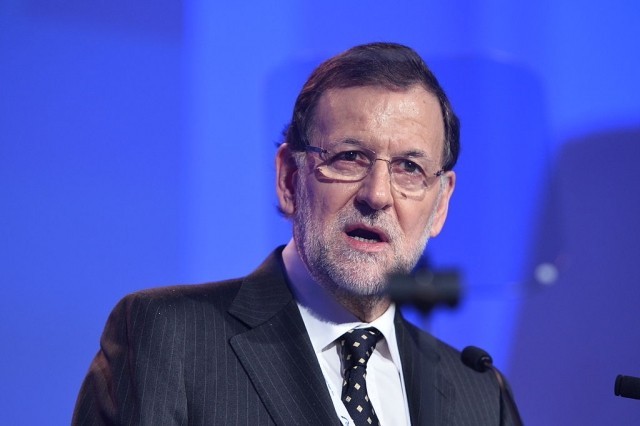 Image: fair use
Image: fair use
The minority PSOE government will be under pressure to deliver on a whole series of questions (cuts in education and health care, labour reform, democratic rights, the national rights of Catalonia). The ruling class will hope to use the Sanchez government as much as it can, in order to discredit it, and then go to new elections with a strong Ciudadanos and a “renewed” and “cleansed” PP.
We have seen a renewal of the mass struggle with very significant movements like the March 8 “feminist strike”, the movement against the scandalous sentence in the “wolf pack” gang rape case, the mass mobilisation against the scandalous sentence of the Alsasu youth, the protests of female migrant farm workers in Andalucia, etc. There have also been a number of significant strikes, like that of H&M, the Bay of Cadis metal workers, etc. If the leaders of Podemos and United Left pursued a strategy of combining mass mobilisation in the streets with pressure in Parliament, they could benefit from the situation. However, their whole conduct under the PP government was one of parliamentary cretinism and complete inability or unwillingness to base themselves on mass action.
The brutal nature of the Spanish state was revealed by the vicious repression of people in Catalonia whose only “crime” was their desire to vote for their own future. Now all the old demons are reappearing. Spanish society is as deeply divided as it was 40 years ago. The youth and the most advanced layers of the working class understand the reactionary nature of the 1978 Constitution and are prepared to fight against it. The situation is highly volatile. After several years of paralysis, the masses have regained a feel for the streets, tearing down the curtain of Spanish chauvinism. The irruption of the pensioners’ movement and, above all, of the struggle of women in the workplace against sexist violence and against the reactionary judicial establishment, have transformed the whole environment. To this must be added the growing indignation of the youth and sections of the working class against the suffocating repressive environment that has characterised the governments of the PP, and the strengthening of republican tendencies in society.
The masses are showing their combative spirit, first of all on the streets of Barcelona, but also in Madrid, the Basque Country, Asturias and Seville. There will inevitably be defeats and setbacks as a consequence of the short-sightedness, stupidity and cowardice of the leadership. But the workers and youth of Spain, who have repeatedly displayed their willingness to fight in recent years, will learn new lessons.
There were many defeats in the past also, like the two black years or the defeat of the 1934 Asturian Commune. But the defeats we are talking about today are not at all comparable to those defeats. Today the forces of the working class remain intact, while the mass basis of reaction is infinitely weaker than it was then: there is no Moorish Legion, no reactionary Carlist peasantry, and the students who joined the Falange in droves then are now solidly behind the working class and the Left.
Finally, in a revolutionary period, such defeats can only be the prelude to new upheavals. In action, on the streets, in the factories and on the campuses, the masses will rediscover the revolutionary traditions of 1931-37 and of the marvellous struggle against the Franco dictatorship. Spain in the next period will once again find itself in the forefront of the revolutionary struggles in Europe.
Catalonia
The attempt of Catalonia to exercise the right of self-determination has been the most serious challenge ever to the 1978 regime. There are different elements to the equation. First of all, the backward and reactionary Spanish ruling class and its state, inherited wholesale from the Franco era. They consider any attempt to question the unity of Spain as a challenge to their whole regime which would then pose other questions (the Monarchy, austerity, etc). Therefore they were prepared to use all means at their disposal to smash the attempt to hold a referendum: police repression, seizing of ballot boxes, sealing off of polling stations, the sacking of the Catalan government and the arrest of its members, etc.
On the other hand, the Catalan government, made up by bourgeois and petty bourgeois nationalists, had lost the support of the Catalan bourgeoisie (the bankers and capitalists), which is opposed to independence. These nationalist politicians considered the independence referendum at worst as a way to exert pressure and extract concessions from the government in Madrid or at best, as a way to exert pressure on and force the EU to intervene and push the Spanish government to organise a mutually agreed referendum. In the case of the bourgeois nationalist PDeCAT (formerly CDC), which was completely discredited by its right-wing austerity policies, repression and corruption scandals, there was also a cynical calculation of using independence as a way to reinvent itself and stay in power. These parties were not prepared to use the revolutionary means that are required in Spain to exercise the right of self-determination.
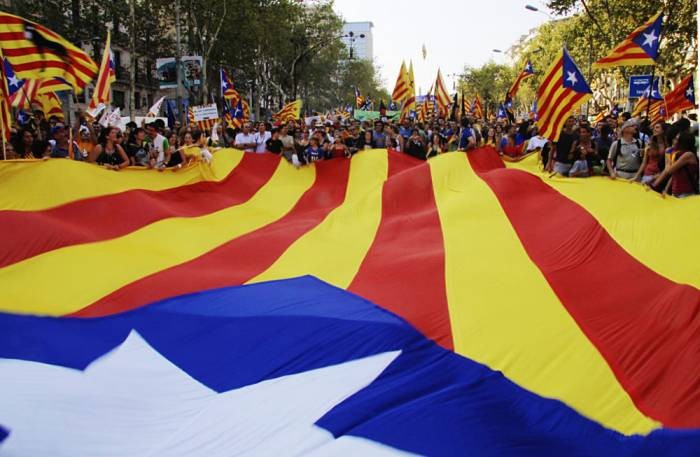 Image: Jordi Joan Fabrega
Image: Jordi Joan Fabrega
They were forced to go further than they intended by the irruption of the masses in the movement, a third factor that they had not taken into account. On September 20 (when 40,000 rallied against Civil Guard searches in Catalan government buildings), October 1 (when hundreds of thousands organised to ensure the referendum took place and 2 million voted) and October 3 (when millions participated in a protest general strike against brutal police repression) the masses entered the scene in a forceful way and started to become aware of their own power. That put the Catalan government in an impossible situation: they were forced to declare the Republic, but they were not prepared to use the necessary methods to defend it: mass mobilisations in the streets, the occupation of official buildings, a general strike, resistance against the Spanish police. In other words, what was needed was a revolutionary uprising. That is what explains their vacillations, wavering and indecisiveness after the referendum, the "suspended" proclamation of the republic on October 10, the constant appeals for negotiation, the near betrayal of the movement on October 25 and the meek proclamation of the Catalan Republic on October 27, after which they fled the scene.
Meanwhile, the masses which participated in the movement (a section of the working class, the youth above all, and the middle-class and petty-bourgeois layers which are the backbone of this democratic movement) have become increasingly critical of their own leaders. The emergence of the Committees for the Defence of the Republic and the role they played in the November 8 general strike show the way forward. A Catalan Republic is a basic democratic demand that challenges the whole edifice of the Spanish regime. Marxists support the struggle for a Catalan Republic but we have the duty to explain that it can only be achieved by revolutionary means. That requires the current leadership to be replaced by one which is firmly based on the working class. Furthermore, the Spanish-speaking workers in Catalonia need to be won over, which can only happen if the struggle for a Republic is linked to the struggle for jobs, housing, against austerity, and is also seen as part of a wider struggle across Spain against the 1978 regime. The slogan which sums these ideas up is "For a Catalan Socialist Republic as a spark of the Iberian revolution".
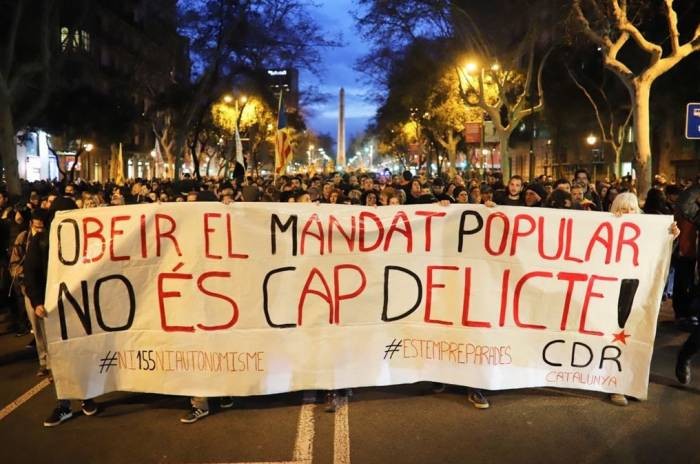 Image: CUP Sant Martí
Image: CUP Sant Martí
The December 21 Catalan elections did not solve anything. In fact, they represent a defeat for the Spanish monarchist regime, as supporters of independence have renewed their majority in the regional parliament and are likely to take control of the Catalan government. In parliamentary terms we are back to a situation similar to that which existed on the eve of the 1 October referendum. With ebbs and flows, the democratic national movement will continue. The task of the Marxists is to intervene energetically and reach the most advanced layers of the youth already drawing revolutionary conclusions.
Britain: the Corbyn phenomenon
Not long ago Britain was one of the most stable countries in Europe. Now it is one of the most unstable countries, experiencing one shock after another. In Scotland the national question has receded somewhat, but it has not been resolved and can resurface with renewed force in the event of a new economic crisis. Beneath the surface of apparent tranquillity there was a seething anger, indignation and above all frustration, a burning desire to change the situation that lacked a clear point of reference.
The change in consciousness was eventually expressed in the extraordinary rise of Jeremy Corbyn. In 2015 Jeremy Corbyn was elected leader of the Labour Party by an accident, but was immediately met with massive opposition from the Blairite wing of the party.
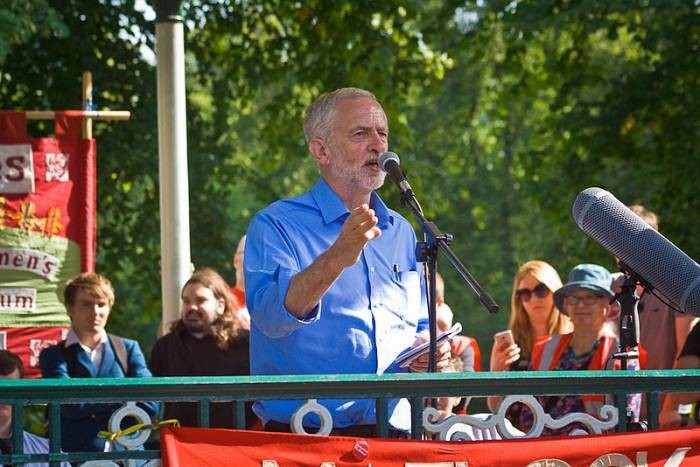 Image: Sophie J. Brown
Image: Sophie J. Brown
Theresa May saw this and drew the logical conclusion. She called a snap election in June 2017, firmly convinced that she would get a big majority and crush the Labour Party. Labour’s Blairite right wing were secretly hoping that Labour would suffer a humiliating defeat, which they saw as the only way to get rid of Jeremy Corbyn, and they attempted to sabotage the campaign.
Everyone was predicting a conservative landslide. But instead it was a crushing defeat for the Conservatives, the media and Labour’s treacherous right wing.
Once the campaign started, Jeremy Corbyn held enthusiastic mass meetings, mainly of the youth. Corbyn came out with the most left-wing programme Labour has had for decades and he immediately connected with the mood of discontent in society. No one expected this political earthquake.
Hundreds of thousands of people, mainly youth, joined the Labour Party. The membership was 180,000 before Corbyn became leader. Now it is 570,000, making Labour the biggest party in Europe. Everybody could see that the real victor in those elections was Jeremy Corbyn. He enjoys colossal support at grassroots level.
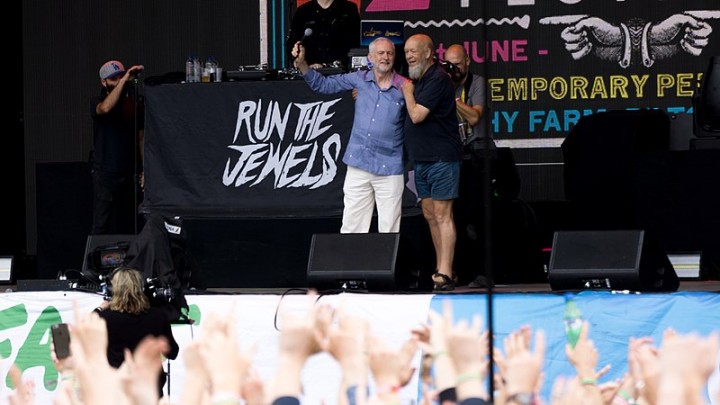 Image: Raph PH
Image: Raph PH
The right wing was decisively defeated at the September 2017 Labour Party conference, which showed that the left has won the majority in the party branches. Despite this, the MPs, the councillors and in particular the full-time apparatus remain under the control of the right wing. The ruling class and its agents will not easily surrender control of the Labour Party, but for the present they are compelled to abandon the attempt to get rid of Corbyn and adopt a waiting tactic.
This subterranean mood of revolt is looking for an expression. In Britain it found one in Corbyn, and it is necessary for the British Marxists to orient their forces to this movement. But while supporting Corbyn against the right wing it is necessary, in a positive and friendly manner, to patiently explain the limitations of Corbyn’s programme and the need for a thoroughgoing revolutionary programme for the socialist transformation of society.
It is likely that Labour will win the next election and Corbyn will form a government. Any attempt to implement the reforms included in his programme will be met with fierce resistance from the ruling class and the active sabotage of the Blairite fifth column, as well as attempts to tame the more radical parts of his program. A section of the ruling class is playing with the idea of a realignment in British politics, in which a new centre formation or coalition would be created with the participation of the “left” of the Conservative party and the right wing of the Labour Party. This is not an immediate perspective, but it could be implemented as a way of bringing down a Corbyn-led Labour government. In a period of political polarisation and economic crisis, however, a centre party or coalition would have very little basis. The experience in government and a possible split in the party would prepare the grounds for a further radicalisation of the ranks of the LP.
Russia
The upheavals in Ukraine and the annexation of the Crimea had a significant impact on the whole political spectrum in Russia. But the nationalist euphoria in 2014, when Putin’s index of popularity exceeded 84%, has gradually dissipated. The fall in oil prices and (to a lesser extent) Western sanctions led to a fall in the ruble exchange rate and a 13% rate of inflation in 2015.
The high refinancing rate of the Central Bank (the interest rate paid by banks when borrowing money from the Central Bank), together with the economic sanctions imposed by the West has had its most serious impact in the financial sector, which led to the bankruptcy of dozens of banks. Faced with this situation the government used financial reserves to support the biggest financial and industrial groups with close links to the state, leading to a further concentration of capital.
On the other hand, the government used administrative measures to combat unemployment, in fact, forbidding mass layoffs. To reduce the budget deficit, a number of very effective measures were introduced, aimed at reducing corruption and tax evasion. This blow was aimed mainly at the middle and petty bourgeoisie, in particular small family businesses such as the owners of lorries and delivery vans.
In addition to purely economic reasons, Putin reacted in this way to moods of protest in the middle strata in the big cities where he is least popular. Here, Putin acts on the principle “to my friends everything is permitted – to my enemies, the full force of the law.”
At the same time, a reform of the higher education system was implemented, which worsened the position of the mass of teachers and lecturers, whom Putin deemed disloyal. In this way, Putin was able to maintain a high level of support both in his own layer and among pensioners and low-paid workers at the expense of the middle layers of the big cities. The discontent of the latter found its political expression through a bourgeois demagogue, Alexei Navalny.
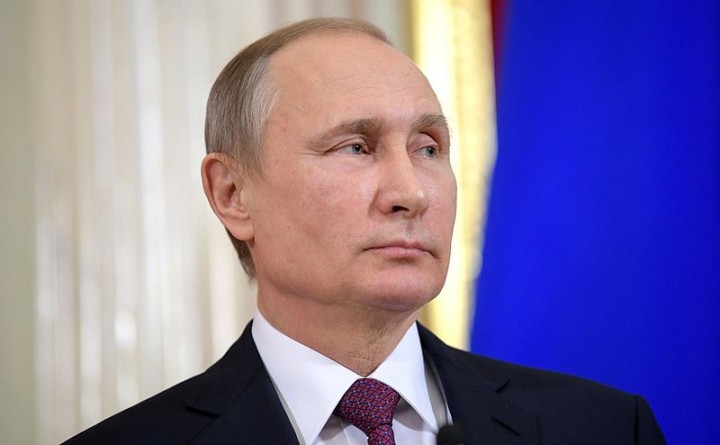 Image: Russian Presidential Press and Information Office
Image: Russian Presidential Press and Information Office
After 2014, all parliamentary parties, including the Communist Party of the Russian Federation (CPRF), adopted a position of complete support for Putin and his government, voting in the Duma for every bill proposed by the government. Of course this does nothing to increase their popularity. For almost ten years, the CPRF has been in constant crisis. There has been a permanent witch hunt in which people were expelled from the party on trumped-up charges of "Trotskyism" – although all of them were loyal supporters of Zyuganov.
The membership of the Communist Party in Moscow, St. Petersburg and other large cities fell by two-thirds. This left a vacuum in the opposition to Putin which was successfully occupied by Navalny. He is a typical demagogue, presenting himself as “a man of the people”, slavishly copying the American tradition. But he stands out sharply in contrast to other oppositionists. The basis of his campaigning is the use of social networks and especially YouTube, where he puts out his videos about corruption in the higher echelons of power.
Navalny himself has been deprived of the right to take part in the presidential election because of two convictions on charges of corruption. Periodically Navalny calls his supporters onto the streets. The scale of these mobilisations across the country is approximately 100,000 people dispersed across major cities. Most of them are young people, who are attracted by Navalny’s apparent determination and his skilful use of social media.
Over the past year, Putin has managed to curb inflation and, in general, overcome the crisis – at least temporarily. However, with the current level of oil prices, Russia's budget deficit remains high and in 2-5 years the reserve funds will inevitably run out, while Russia’s opportunities for external borrowing are now minimal. If the price of oil stays low for three or four more years, the whole situation will change into its opposite.
When that moment comes, Putin (who will obviously be re-elected president) will face a serious problem. The government will no longer be able to solve the budget deficit without making deep cuts in public spending. At that point his popularity will evaporate completely. That is why Putin is using every opportunity to tighten his control over the internet, and impose restrictions on freedom of speech and other democratic rights.
But for the time being Putin still has room for manoeuvre. He can avoid slashing public spending or making drastic attacks on living standards. That is the main reason why the opposition has not met with any great success in mobilizing proletarian elements.
At this stage, those who participate openly on the streets are mainly middle class and petty bourgeois. Although Navalny has advocated an increase in the minimum wage, he has not had any success in establishing a link with social problems. There is a limit to how far the opposition to Putin can succeed on the basis of democratic demands and denunciation of corruption.
Nevertheless, many young people have rallied to the opposition, especially school and university students. They have taken to the streets in significant numbers. This is an important symptomatic development. The history of Russia shows that the awakening of the student youth is a sure anticipation of a big future movement of the working class. “The wind always blows through the tops of the trees first.”
Eastern Europe and the Balkans
The rise in Eastern Europe of right-wing nationalism and anti-immigration rhetoric is an attempt on the part of the governments of the region to divert the growing malaise caused by the low standards of living and the toll imposed by the capitalist crisis on the mass of the population, in a situation where the working class has not yet decisively entered the scene.
Higher rates of GDP growth (relative to those of Western European countries) mask the reality of extreme capitalist exploitation of a skilled working class under a regime of low wages, imposed to maximise capitalist profits and foreign investment. A recent study of the European Trade Union Institute (“Why central and eastern Europe needs a pay rise”) shows that wage differentials between Western and Eastern Europe, which up until 2008 were slowly decreasing, have increased over the past decade.
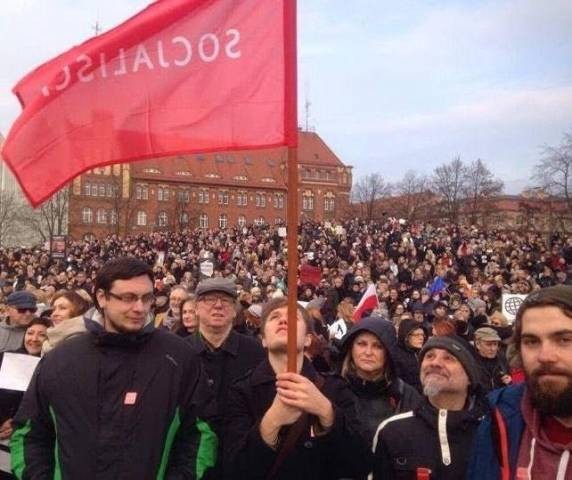 Image: own work
Image: own work
As a consequence, there have been important signs of radicalisation of the youth, the first symptoms of which are the mobilisations against corruption in several countries, which reflect a growing rejection of the whole establishment. Key sections of the working class have also begun to go on the offensive on the industrial field – in many cases for the first time since the collapse of the Stalinist regimes – carrying out important strikes aimed at substantial wage increases and better working conditions.
In Slovakia, thousands of students demonstrated in April 2017 demanding the resignation of Prime Minister Robert Fico on corruption charges. This was followed in June by a massive strike of the 12,000 workers at the three VW plants in Bratislava, which won a 14% rise in wages. A 7% wage rise was also granted by KIA and Peugeot to avoid strikes, inspiring worries that the movement could spread. Precisely, on March 15, 2018 Prime Minister Robert Fico (Social Democrat) resigned due to the scandal unleashed after the February 25 killing of investigative journalist Jan Kuciak, who was investigating the Italian mafia’s business affairs in the country and its contacts with the entourage of said politician. This resignation came after a wave of mass demonstrations in the main cities that demanded the fall of a government cornered by corruption cases.
Important movements have also taken place in opposition to reactionary measures. In Poland, the attacks by the right-wing government against what remains of abortion rights provoked the Black Protest movement of tens of thousands of women in October 2016, which forced the government to retreat.
In the former Yugoslavia the process of radicalisation is more advanced. A growing mood of rejection of the corrupt, reactionary bourgeois regimes on part of the youth and the working class was clearly expressed in the insurrectionary movement of February 2014 in Bosnia. Over the past year there have been significant strikes. The all-out strike of 2,400 workers of the FIAT plant in Kragujevac in July 2017 is just the most significant of a number of radical strikes in smaller factories and workplaces. Repeated strikes and protests were also carried out by the railway workers in Bosnia.
The youth protests against Vucic’s victory in the Serbian presidential election of April 2017, while broadly dominated by petty-bourgeois illusions, have revealed a growing layer of youth open to revolutionary ideas. The potential for the Yugoslav Marxists was shown by the fact that they had leading roles in the protests in Novi Sad.
Latin America
The electoral defeat of Kirchnerism in Argentina, the defeat of the PSUV in the National Assembly elections in Venezuela, the defeat of Evo Morales in the referendum in Bolivia and the removal of Dilma in Brazil have plunged the reformists and “progressive” intellectuals on the continent into despair. They talk of a “conservative wave” and the advance of counter-revolution, without understanding any of the real processes involved.
For a period of 10 or 15 years, most of South America experienced a revolutionary wave, which affected different countries with different degrees of intensity. There was the election of Chavez in Venezuela in 1998 and the revolutionary events in the defeat of the coup in April 2002 and the struggle against the bosses’ lockout in December 2002-January 2003, the Argentinazo in 2001, the uprising in Ecuador in 2000 which overthrew Mahuad, then the overthrow of Lucio Gutierrez in 2005, which led to the election of Correa in 2006. In Bolivia there was the Cochabamba “water war” in 1999-2000 and then the Gas War uprisings of October 2003 and June 2005, which led to the election of Evo Morales. In Peru there was the Arequipazo uprising in the south in 2002.
One might add to these the massive movement against election fraud in Mexico in 2006 and the Oaxaca commune of the same year, the huge and sustained movement of the Chilean students, the mass mobilisations in Honduras against the coup in 2009, even the election of Lula in Brazil in 2002, although of course not a revolutionary event in itself, all reflecting the yearning of the masses for fundamental change.
As a by-product of these huge movements of the workers (and in some countries the peasant masses) a number of governments came to power that were generally described as “progressive” or “revolutionary”. Clearly they were different one from the other. While for instance Chavez, in a confused way, groped for and was pushed towards revolutionary change, Evo Morales, Correa and the Kirchners in Argentina were striving to re-establishing order, recomposing the bourgeois state of these countries, and in order to do that they had to make important concessions, after the entry of the masses into the scene, while Lula and Dilma carried out a programme of counter-reforms. The Left in El Salvador has had almost no room for manoeuvre and is starting to roll back some of its modest reforms, generating disillusionment amongst the masses towards the FMLN. This mood is being capitalised, in the first instance, by the mayor of San Salvador, Nayib Bukele, who has been expelled from the party and has widespread sympathy amongst the youth.
However, all of these governments enjoyed a certain degree of stability for a prolonged period of time. This in part was the result of the strength of the movement of the masses, which the ruling class could not defeat in a direct confrontation (the coups in Venezuela 2002, Bolivia 2008 and Ecuador 2010 were defeated). Above all, they benefited from a period of high prices of raw materials and oil which allowed them to carry out some social programmes while avoiding a direct clash with the masses.
Driven by economic growth in China, prices of raw materials went up steadily between 2003 and 2010. Oil prices increased from $40 a barrel to over $100. Natural gas had been around $3/MMBtu and increased to between $8 and $18. Soybeans jumped from $4 to a peak of $17/bu. Zinc went from a low point of under $750/mt to a record high of $4,600, copper from under $0.60 per pound to $4.50 and tin from $3,700/mt to a peak of $33,000/mt.
This boom in the prices of commodities and sources of energy which gave these governments certain room for manoeuvre came to an end and brought the whole region into recession in 2014-15. This is the root economic cause for the electoral and other defeats of these governments which had always remained within the limits of capitalism.
 Image: stttijn
Image: stttijn
With the rise of the Venezuelan Revolution, Cuba had a certain economic respite. This has now come to an end. The Cuban economy is still based on the planned economy, but the reforms which have been introduced have opened a bigger space for capitalist economy, allowing small businesses as well as attempting to attract large scale private investment. The aim is to increase productivity by using capitalist methods without introducing any measures of workers’ control. Even today many of the social conquests remain, but their scope is increasingly limited and its quality worsened. There is a growing social differentiation. This is very dangerous. This year there will be elections in which for the first time the president will not be one of the Castros nor anyone from the historic leadership of the revolution. We will see clashes and pressures by the capitalist right wing, internal and foreign, but also a reaction in the opposite direction on the part of those who have not benefited from these reforms and those who want to defend the socialist revolution.
Despite the pathetic moaning of the Latin American “Left”, the removal of Kirchner in Argentina and Dilma in Brazil cannot be attributed to a “shift to the right”. The coming to power of Temer and Macri has seen massive protest movements of the working class against the open policy of attacks carried out by the right wing. What is opening up in Latin America is not a period of social peace and capitalist stabilisation, but rather one of sharpening contradictions and increased class struggle. This has been proven with the insurrectionary movement in Honduras, after the 2017 election. Before, in Guatemala, in 2015, an inter-bourgeois conflict opened the way for a mass mobilisation of the youth, the peasant organisations and the working class. That process has not finished yet. In 2017 we saw a general strike demanding the resignation of president Jimmy Morales and 107 members of parliament. Other countries will follow the same road, like Mexico which will hold presidential elections this year, an event which the masses will use to express that they are sick and tired of capitalist barbarism.
Venezuela
The attempt of the Venezuelan oligarchy, with the backing of imperialism, to overthrow the Maduro government seems to have been defeated for now. The mistakes and vacillations of the opposition leadership, as well as the reaction of the masses, who came out in force during the Constituent Assembly elections in July 2017, put a temporary end to the opposition’s offensive in the first half of the year. But that does not change anything fundamental in terms of the economic crisis, or the policies of the government.
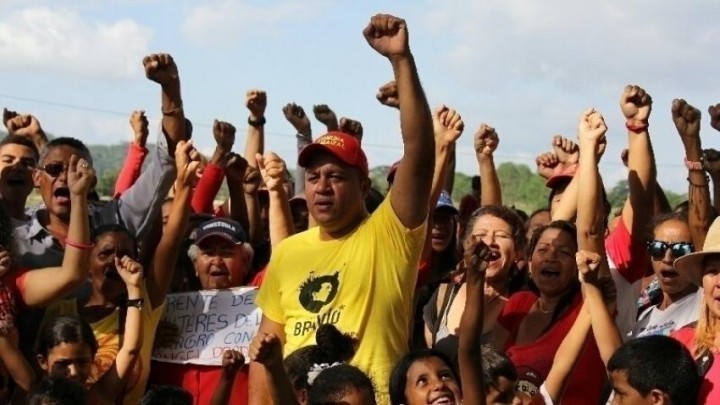 Image: Green Left
Image: Green Left
Venezuela remains mired in a deep recession, with hyperinflation and rapidly diminishing foreign currency reserves, and this is having a very negative impact on the living standards of the masses. Imperialism continues to tighten the noose with financial sanctions. The government continues a policy of making concessions to the capitalists and negotiating with the political representatives of the opposition. Their only aim is to remain in power. The temporary defeat of the opposition’s offensive has opened up the window for a sharpening of the internal differentiation within the Bolivarian movement. There have been workers’ demonstrations and the emergence of left-wing candidates to rival the official ones in the municipal elections.
Our position is clear: we oppose the overthrow of the Maduro government by the opposition as that would be a disaster for the masses. At the same time we cannot support the policies of the government, which lead directly to disaster and defeat for the Bolivarian revolution.
There is a growing mood of criticism towards the Bolivarian leadership, which cannot have the same authority as Hugo Chavez. The decision of Eduardo Saman, a former minister who stood out as a champion of workers’ control and an opponent of big business and capitalist multinationals, to stand as a candidate in the municipal elections of December 2017 was a clear indication of this changed mood.
Although it was always clear that the bureaucracy was determined to sabotage Saman’s campaign, it was nevertheless a turning point that opens up new possibilities for the Marxist tendency in Venezuela. The 20 May presidential election did not substantially change anything. The core of the chavista vote (30% of the electorate) came out to vote for Maduro. The opposition is demoralised and divided. The government continues to pursue a disastrous economic policy combining concessions and appeals to the private sector with attempts to regulate capitalism. The economic crisis continues to worsen grinding key sectors to a halt. The impact of sanctions combined with corruption, mismanagement and sabotage have led to a catastrophic collapse in oil production. Hyperinflation has pulverised the purchasing power of wages. In the countryside there is an open battle between the comunero peasant collectives and the state apparatus. Amongst workers there is the beginning of a protest movement in defence of wages. There are rumblings of a coup within the army. The tragedy of the Venezuelan revolution is the lack of the subjective factor.
India and Pakistan
Narendra Modi came to power in 2014 on the basis of a widespread disillusionment with the Congress party, both by the working masses and by a layer of the bourgeoisie itself. But he has not been able to satisfy any of the forces that brought him to power. His demonetisation drive and the Goods and Services Tax reform were meant to facilitate business, but instead they have added to the weakening of the economy, which fell from above 9% growth rates to less than 7% in 2017.
The brief period of high growth between 2014-2016 has now given way to a sharp slowdown. Even during the period of faster growth unemployment actually increased and Modi launched a whole series of attacks on the workers’ movement. The result has been a rise in class struggle. Students, peasants and workers have all taken to the streets. In September 2016 more than 180 million workers came out on strike that is around 50% more than during a similar general strike called a year earlier.
In Kashmir too, the masses took to the streets in a movement that shook the government, which only managed to temporarily subdue the movement by using heavy repression. Nevertheless, the movement had a certain influence in the rest of the country, in particular amongst the student youth.
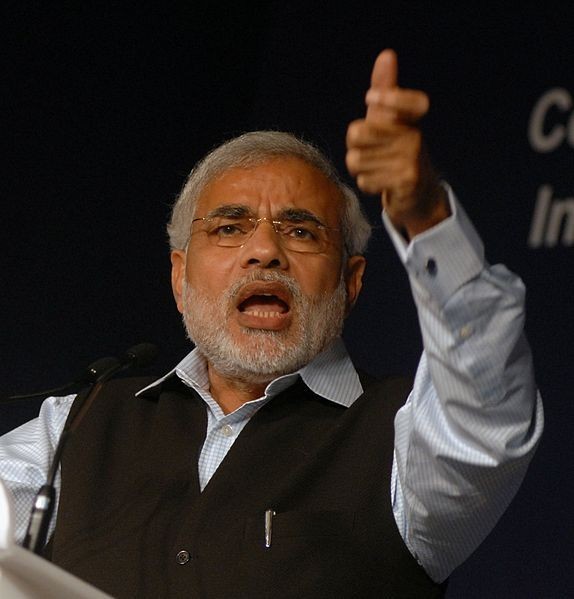 Image: WEF
Image: WEF
Modi has been trying to divert attention away from these developments by whipping up Hindu sectarianism, but this can only work for a limited period. At a certain point it will be cut across by the rising working class.
The events in Pakistan and India are closely linked. The Indian and Pakistani ruling classes have a common interest in maintaining a state of conflict between the two countries in order to divert the attention of the masses. But the position of the Pakistani ruling class is increasingly weak.
As the US is withdrawing its aid to the regime, China is stepping in. The Chinese have a special interest in Pakistan as an ally and buffer against India, as well as a hub for Chinese naval and maritime operations in the Indian Ocean. However, Chinese investments are not creating jobs or solving the contradictions in society.
The national question is becoming increasingly poisonous and in places such as Baluchistan, the Chinese presence is exacerbating sectarianism, which is merely a cover for a bloody proxy war between antagonistic external powers (America, China, Saudi Arabia, Iran...). Every day the reactionary policies of the ruling class are being exposed in the eyes of the masses, who have nothing but contempt left for the rotten elite that rules and plunders the country.
In the past the PPP leaders played a role in channelling the anger of the masses, leaning on the tradition of struggle in the late 1960s under Ali Bhutto. But after long periods in government carrying out austerity, the PPP is mired in corruption and largely discredited. This allowed Sharif’s Muslim League to make a comeback. Now Sharif is also exposed in the eyes of the masses as a corrupt bourgeois politician who has nothing to offer them.
There has been a growing mood of rejection of all the politicians, who are seen as self-serving anti-working class and anti-poor gangsters. In the past the army would have taken power by now, but the army itself is split and demoralised. The generals are reluctant to accept responsibility for clearing up the mess. It is in this context that we see the beginnings of struggles of the workers and youth. Political instability in Pakistan and ferment among the masses have emerged in recent months, including through the creation of the Pashtun Tahafuz Movement, a protest movement that came into being to highlight the situation of poverty and the repression of the Pashtun minority. Over a short period of time this movement has gathered a lot of forces and, despite the violent repression of the Pakistani regime, it had the potential of overcoming the ethnic divisions thanks to its denunciation of the corruption and the barbarism of the Pakistani politicians and military.
Africa
In South Africa, many years of rising class struggle have shattered the tripartite alliance (ANC-CPSA-COSATU). The strike movements and the movement of the youth in the universities led to the rise of the Economic Freedom Fighters and the new trade union federation led by NUMSA. Although the movement has temporarily subsided, the regime has been seriously affected by all these upheavals.
Economic crisis, mass anger, the open looting of state resources by the upstart black elite around Zuma and the Gupta family, is destabilising the situation and undermining the authority of the ANC. The big bourgeoisie, which collaborated with Mandela to stabilise the situation after the revolutionary events of the 1980s and 1990s, has come into conflict with the nouveau riche layer and the ruling clique around Zuma.
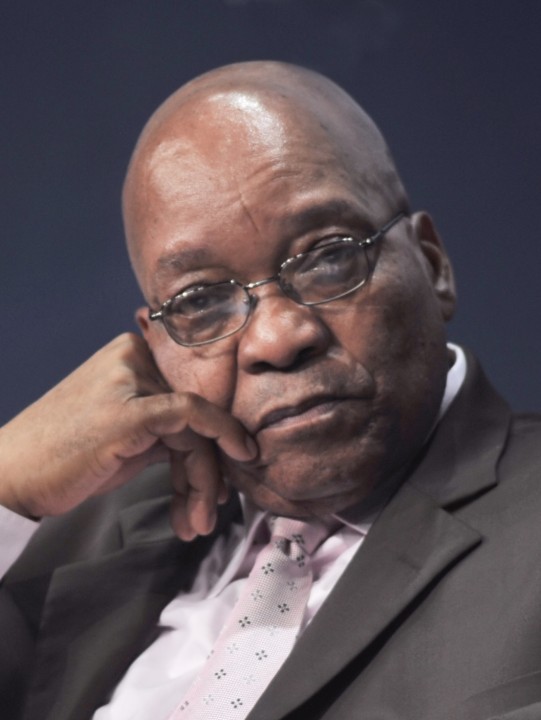 Image: WEFA
Image: WEFA
On the other hand, the ruling class cannot afford to discard the ANC because it does not have an alternative party to stabilise the situation. Aware of this, the Zuma wing has been recklessly raising the stakes in a dangerous game. This open split between the two camps and the potential split within the ANC could have revolutionary consequences for Africa’s most advanced economy.
In Nigeria, after the tremendous upsurge in class struggle in January 2012, the main pillar of bourgeois rule, the PDP, stood discredited in the eyes of the masses. That is why they hurriedly cobbled together a new party, the APC – in reality a fusion of smaller parties – and put at its head Buhari, whom they considered a good candidate to garner support among the mass of the population and cut across the growing radicalisation.
This manoeuvre was possible because the leaders of the NLC, the main trade union federation, instead of building on the 2012 movement, spent all their authority in reining in that movement, while at the same time refusing to promote an independent party of the working class. It is in this vacuum left by the labour leaders that Buhari could step in. But in spite of all this, none of the burning problems facing the Nigerian masses have been solved. This was recently expressed in the agitation for a Biafran Republic in the south east. Although crushed by the military, it reveals the underlying tensions in Nigerian society. And once the last remnants of illusions in Buhari finally dissipate, we will see a resurgence of the class struggle on an even bigger scale than in 2012.
In West and Central Africa, mass movements against the corrupt and exploitative local bourgeoisies in several countries have increased sharply over the past period. These were enormous movements that stretched over long periods of time and mobilised millions of peoples. The masses closely followed the heroic uprising in Burkina Faso, while the fragile economies of these countries are being hit particularly hard by the global economic crisis. The attacks by the weakening regimes on democratic rights, more recently in Togo and the DRC, served as the straw that broke the camel's back. In particular, the mass of young people equate their general oppression with the decades old governments. The widespread misery in the region, as well as the treacherous role of the bourgeois opposition leaders – whose sole interest is to replace the regime heads – confirm both the correctness of the theory of the permanent revolution and the need to build an international revolutionary organization. Because of lack of a fighting leadership, after a huge upsurge of mass mobilisations, the movements receded. The only conclusion that the masses can draw from all this is that they can have no trust in the old leadership. Marxist theory and revolutionary organization is what is required to break the logjam.
Pessimism of the bourgeois
The hundredth anniversary of the October Revolution provided the strategists of Capital with an opportunity to reflect on history – and worry about the future. On August 15th, 2017 Martin Sandbu wrote in the Financial Times:
“Two anniversaries we mark this year – the centenary of the Russian Revolution and the decade since the start of the global financial crisis – have more in common than is apparent at first sight.
“The global financial crisis […] shook to its foundations the model that had emerged victorious from the cold war.
“The stultifying communism that the Soviet bloc had evolved to by the 1980s collapsed under the weight of its own economic and political contradictions. The political turmoil of the last year demonstrates that we are now watching to see whether open market economies will suffer the same fate.” (Our emphasis)
He continues:
“Friedrich von Hayek’s insight that flexible market prices contain more information than any planning mechanism can hope to gather centrally; and that dispersed decision-making therefore acts more efficiently than state authorities can do. […]
“Yet it had a rude awakening in the global financial crisis, which undermined any claim of western financial capitalism to being the best way to organise an economy.”
And he concludes:
“What happened 10 years ago this month was the horrifying realisation that financial claims accumulated over the previous boom years did not add up, that the future economic production which they were claims on was insufficient for them all to be honoured in full.
“[…] market liberalism, in its turn, betrayed the dream it had promised. Western economies are today far poorer than the trend before the crash predicted. The crisis and its aftermath have left the young, in particular, with little reason to hope for the same opportunities to prosper as their parents and grandparents.
“[…] a social system can survive disillusion for a long time. […] But when people can no longer count on their livelihoods, support snaps.”
Some of the more serious capitalist experts are beginning to understand that their recipes of the last 30 years are no longer working. In an article that appeared in June 2016 in the German paper Die Zeit under the title “Neoliberalism is dead” we are informed that even the IMF has admitted that their policies do not have the desired effect. But of course, they never draw all the necessary conclusions.
Wolfgang Streek of the Max Planck Institute listed all the problems of capitalism in a long article published in New Left Review entitled, “How will capitalism end?” (May/June 2014), which in 2016 he expanded into a book. He says that there is a crisis of legitimacy of the capitalist system because it is no longer providing what it did in the past and people are therefore beginning to question the system. This explains the electoral volatility that can be observed in many countries. He also poses the question as to whether a “democratic system” can provide the policies that capitalism needs. What he means is whether they can impose on the working class what the bourgeois need.
In his article Streek states that capitalism “will for the foreseeable future hang in limbo, dead or about to die in an overdose of itself, but still very much around, as nobody has the power to move its decaying body out of the way”. This is not a bad description of the state of present-day capitalism.
It is significant that Martin Wolf, chief economics commentator of the Financial Times, felt the need to answer Streek in an article with the interesting title “The case against the collapse of capitalism.” (FT 2 November 2016). How well the strategists of capital understand the sickness of their own system!
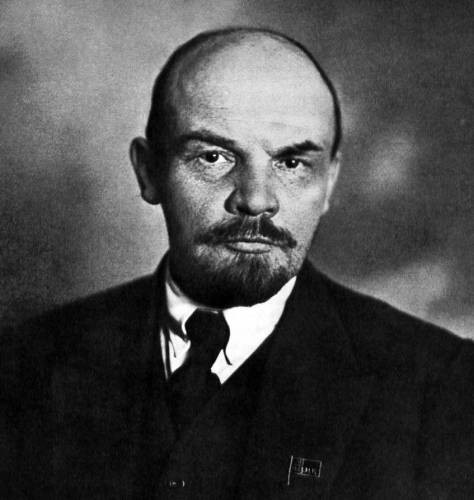 Image: public domain
Image: public domain
Lenin explained that if it is not overthrown, the capitalist system will always recover from even the deepest crisis. Even in the 1930s there were periods of recovery. The bourgeois press has been talking about a recovery for the last seven years. In reality this is the weakest recovery in history and certain things flow from this.
Of course, the capitalist system still has important reserves and if the capitalists and bankers feel themselves threatened with losing everything, they will introduce Keynesian measures. But these reserves are not unlimited and they have been used up at an alarming rate in the last ten years. As a result, when the next crisis comes, as it inevitably will come, they will be in a far weaker position to mitigate its consequences than they were previously.
They constantly repeat that they have learned the lessons of 2008. But they also said they had learned the lessons of 1929. And as Hegel pointed out, anybody who studies history will have to conclude that nobody has ever learned anything from it.
In the final analysis, no matter what the bourgeois do, whether they adopt Keynesianism, monetarism, protections or anything else, they will be wrong. In the Middle Ages the priests used to say: all roads lead to Rome. Now we can use a slightly different variant: under capitalism, all roads lead to ruin.
The molecular process of revolution
Not so long ago it seemed that nothing much was happening in the world. A discussion of world perspectives would have to concentrate on one or two countries. But now the same revolutionary process is taking place to a greater or lesser intensity in every single country of the world without exception. What we are therefore discussing is a general process of worldwide revolution.
For Marxists, a discussion of economic perspectives is not an academic or abstract intellectual exercise. What is important is its effect for the class struggle and consciousness. But since consciousness always lags behind events, there was an inevitable delay between the beginning of the crisis and the intensification of the class struggle.
The bourgeoisie, always blindly empirical, were unable to see the explosive accumulation of subterranean discontent that was quietly gathering force. They were congratulating themselves that no revolution had taken place. Once they had recovered from the initial shock, for the bankers and capitalists it was “business as usual” Like a drunken man dancing on the edge of a precipice, they carried on with the merry carnival of money-making, which acquired an even more feverish pace while the conditions of the masses went from bad to worse.
Trotsky explained what he called the molecular process of revolution. In the History of the Russian Revolution he points out that, what determines the consciousness of the masses is not just the economic crisis, but rather the accumulation of discontent built up over the whole previous period. The discontent of the masses accumulates unnoticed until it finally reaches that critical point when quantity is transformed into quality.
Now, suddenly, the sense of relief of the ruling class has been replaced with pessimism and foreboding. There are social and political convulsions everywhere, accompanied by extreme instability on a world scale and violent alterations in world relations.
Even if the economy improves, it does not automatically register in the consciousness of the masses, which has been shaped by the memories of decades of stagnant or falling living standards. The very weak recovery in the USA signifies only a very relative improvement, confined to certain sectors. It does not affect the unemployed workers in the rustbelt. And everywhere else, it does not feel like a real recovery, and it has not restored any sense of confidence in the system or optimism in the future, but quite the opposite.
We see the same story reflected in the British referendum on EU membership. There are many reasons why the vote went in favour of Brexit. But a very important reason was revealed in the sharp regional differences between north and south. The bankers and speculators of the City of London did very well out of membership of the EU, which gave them privileged access to the lucrative financial markets of Europe. But membership has done nothing whatsoever for the poor areas of the north-east or Wales, which have suffered decades of deindustrialization, and the closure of the coal mines, steel plants and shipyards.
The growth of inequality
Everywhere there is a burning anger against grotesque levels of inequality, with obscene wealth of a tiny parasitic minority standing in sharp contrast to the growing poverty and despair at the bottom. The serious bourgeois are increasingly worried about this tendency because it is endangering the stability of the entire system. Everywhere there’s a burning hatred of the rich. Many people ask: if the economy is doing so well, why are our living standards not improving? Why are they still cutting welfare, health and education? Why do the rich not pay taxes? And to these questions they find no answers.
The bourgeois are getting increasingly alarmed about the political consequences of the crisis. Far from feeling the benefits of the so called recovery, most working class people are worse off than they were before the crash. The McKinsey Global Institute found that 65-70% of “income segments” in advanced economies experienced either stagnation or a fall in their income between 2005 and 2014. Countries like Italy saw all income segments affected. (Poorer Than Their Parents, McKinsey Global Institute)
In the wealthiest and most powerful capitalist country that has ever existed there has been no real increase in living standards for nearly forty years. Indeed, for most Americans living standards have been falling. And this is no exception. In all countries, the present young generation is the first since 1945 that cannot expect a better standard of living than their parents.
Polarisation of wealth in the US continues unabated. From 2000-2010 profits went up by 80% and wages by 8%, while average family incomes actually went down by 5%. These figures show that the massive increases in profit were achieved at the cost of the working class. (The Economist, "What about the workers?" May 25th 2011).
The figures for pre-tax and disposable income understate the case. They do not take into consideration other factors such as increasing working hours and increasing casualization, whether due to zero hour contracts or temporary employment, and cuts to welfare services. These all add to the total pressure on working class families.
The crisis has its most painful and direct effects on young people. For the first time in many decades the new generation will not have the same living standards as their parents. This has serious political consequences. In all countries, the intolerable pressure on the youth finds its expression in a sharp increase in political radicalisation. On all questions the youth stands much further to the left than the rest of society. They are far more open to revolutionary ideas than other layers and are therefore our natural constituency.
Lessons of the collapse of Stalinism
In 1991 the collapse of the Soviet Union changed the course of history. At that time, the bourgeoisie and its echoes in the Labour movement, the reformists, were euphoric. They talked about the end of socialism, the end of communism, and even the end of history.
What Francis Fukuyama meant by his notorious aphorism was not that history as such had ended, but that the collapse of the Soviet Union meant that socialism was finished. It would therefore logically follow that the only system which could possibly exist was capitalism (the free market economy) and in that sense history had ended.
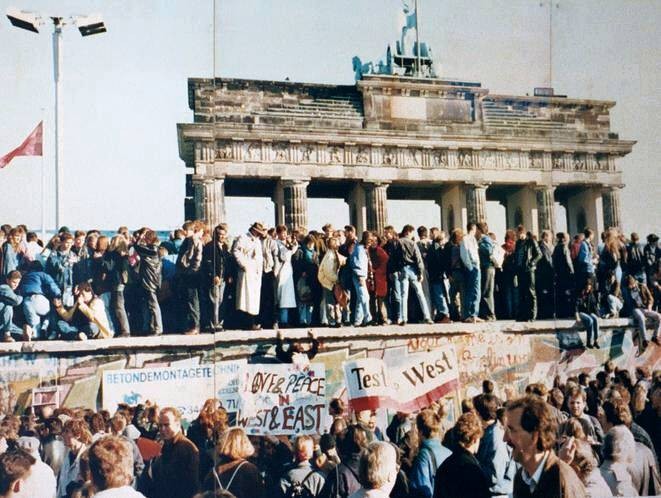 Image: public domain
Image: public domain
What was astonishing about the fall of Stalinism was the speed with which the apparently powerful and monolithic regimes collapsed once they were challenged by mass movements in Eastern Europe. That was a reflection of the internal rottenness and decay of the regime. But the decay of senile capitalism is increasingly becoming clear to millions of people.
When the Berlin Wall fell Ted Grant predicted that seen in retrospect the fall of Stalinism would only be the first act of a worldwide drama which would be followed by an even more dramatic second act – the global crisis of capitalism. We now see the truth of this statement. Instead of universal prosperity there is poverty, unemployment, hunger and misery. Instead of peace there is war after war after war.
The same processes that suddenly caused the downfall of Stalinism can occur in capitalism. In one country after another we are witnessing sudden shocks that are testing the resilience of the system and exposing its weaknesses.
The institutions of bourgeois democracy, which were previously trusted blindly, are beginning to be discredited everywhere. People do not trust the politicians, the government, the judges, the police, the security services, even the Church: the whole system is coming under intense scrutiny and criticism.
A representative of WikiLeaks was asked on British TV: “are you seriously suggesting that the intelligence services of the US are telling lies?” He replied, “why not? They always tell lies!” This is what many people are now beginning to believe.
The mass organizations: the crisis of reformism
The crisis of capitalism is also the crisis of reformism. Everywhere the traditional parties of both the right and the left are in crises. Organizations that seemed to be solidly based and immutable are entering into crises, declining and even collapsing altogether. The reformist parties that have collaborated in governments that carried out deep cuts have been rejected by their traditional electorate.
To one degree or another, and at one pace or another, the same processes can be seen in practically every country in Europe. As in France, so too in the Netherlands, where the right-wing party of Geert Wilders was defeated in the elections. The bourgeois breathed a sigh of relief. But far more significant than the defeat of Wilders was the crushing debacle of the Dutch Labour Party, which was practically wiped out. The party lost 75% of its support.
The rise of the Workers' Party of Belgium is also a significant development. This ex-Maoist sect is now a left-reformist party, although it claims to be Marxist and Communist. In Wallonia, the French-speaking region, they are only just behind the Socialists. The same is true in Brussels. In the red belts they can get around 25% of the votes. But they are also beginning to grow in Flanders.
The masses are looking for and demanding a change. They need to find an organised political expression for this anger. Over the last period, the Greek masses have done everything in their power to fight to change society. There have been many mass strikes, general strikes and mass demonstrations. But here we come to the most important question: the subjective factor.
In their attempt to find a way out of the crisis, the masses turn first to one political option, they put it to the test, and then discard it and look for another. This explains the violent swings of public opinion to the left and the right. But they do not find what they are looking for. The people who ought to lead – the labour politicians, the social democrats, the so-called ex-communists, above all the trade union leaders – don’t want to fight against austerity and for a serious change in society.
Trotsky explained that betrayal is implicit in reformism. By this he did not mean that all reformists betray the working class deliberately. There can be honest reformists as well as the corrupt careerists and bureaucrats who are the agents of the bourgeoisie within the workers’ organizations. However, even honest left reformists have no perspective for a socialist transformation of society. They believe that it is possible to carry out the reforms that the workers require within the limits of capitalism. They regard themselves as supreme realists, but under conditions of capitalist crisis this “realism” stands exposed as the worst kind of utopianism.
The Pasok, which for decades was the mass party of the Greek working class, collapsed because of its betrayals and participation in governments of cuts. The workers turned to Syriza, which was previously a very small party. Alexis Tsipras became the most popular political leader in Greece. He held a referendum, asking “Should we accept the cuts of Frau Merkel?”, and there was a massive response.
The people of Greece voted overwhelmingly to reject austerity: not just the workers but also the middle classes, the taxi drivers and small businessmen. At that moment Tsipras could have said, “We are not going to pay one euro to these gangsters! Enough! We’ll take the power into our own hands and appeal to the workers of Spain, Italy, Germany and Britain to follow our example. We must fight against the dictatorship of the bankers and capitalists: for a genuinely democratic socialist Europe.”
Had he done that, he would have received overwhelming support. People would have been dancing in the streets. And the Greek people would have been prepared to make sacrifices, big sacrifices if necessary, to back their leaders – on one condition: that they were convinced that they were fighting for a just cause and the sacrifices would be the same for all. Tsipras could have lifted his finger and it would have been the end of capitalism in Greece. He could have expropriated the bankers, the shipping magnates and industrialists.
But Tsipras is not a Marxist. He is a reformist and therefore it did not enter into his head to base himself on the power of the masses. He surrendered to the blackmail of Berlin and Brussels and he signed a far worse deal than the one originally proposed, leading to a colossal demoralization and big drop in support for Syriza, although he is still there because there is no alternative.
The process also affected Spain, which is passing through a profound political crisis. Like the rise of Syriza in Greece, the rapid rise of Podemos was a clear reflection of massive discontent with the old parties and a burning desire for change. But the confused and vacillating policies of the leadership caused disappointment among its followers even before they had come to power. Pablo Iglesias’ flirtation with Social Democracy led to a slump in the votes for Podemos and a sharp division among its leaders.
 Image: Flickr, Parlamento Europeo
Image: Flickr, Parlamento Europeo
For some time the leaders of Podemos have been looking to their right – towards the PSOE, in the hope that some sort of deal could be struck to remove the hated Rajoy government (which eventually happened with the collapse of the PP government in June). This has led them to a moderation of their language and they are under enormous pressure to appear more respectable and “statesman-like”. This will further confuse and disorient their supporters.
The new leader of the Socialists, Pedro Sanchez, is the palest of pale reflections of Jeremy Corbyn and Mélenchon. Nevertheless, for having dared to pose the question of a coalition government with Podemos and the Catalan nationalists, the Spanish ruling class attempted to remove him. This was rejected by the ranks in the internal elections, which returned Pedro Sanchez as general secretary.
The above-mentioned cases are different variants of the same process. Everywhere the reformist and ex-Stalinist parties are in crisis. After years of betrayals, class collaboration and a never-ending drift to the right, many of the old mass organisations have been thoroughly discredited. Therefore, it is not certain that the rising class struggle will find a reflection through these. Some have experienced splits, while others have disappeared altogether (Italy is an extreme example of this, where both the old socialist and communist parties have vanished). We have also seen the emergence of new political formations, such as Syriza, France Insoumise and Podemos and, depending on the traditions and concrete conditions in each country, we may see similar phenomena emerge in other countries, and we will have to orientate accordingly.
Like the foam on the waves of the sea, these new formations are a reflection of deep and powerful currents beneath the surface. However, these new formations lack a stable base in the working class and the trade unions. As a result of this, and also their mainly petty bourgeois composition, they are inherently unstable and may collapse as quickly as they arose.
The example of Corbyn in Britain is so far an exception to the rule. As we have explained, this development was the result of an accident, but as Hegel explained, an accident that revealed a necessity. The strong side of the Corbyn movement is that it has provided the necessary focal point for the accumulated discontent of the masses, especially the youth. Its weak side will be revealed when the limited nature of the left reformist programme is put to the test in a Left Labour government.
This means that our tactics have to be flexible at all times, attuned to the concrete conditions and the level of consciousness of the working class and above all its most active and advanced layers.
We will support the left reformists in the fight against the right wing, always pushing them to go further. But at the same time we must patiently explain to the advanced workers and youth the limitations of a programme that does not aim to overthrow capitalism but seeks only to reform it from within – a utopian policy which, irrespective of the good intentions of its advocates, under the conditions of capitalist crisis, can only lead to defeat and prepare the way for a swing to the right.
Radicalisation of the youth
Political and social instability are sweeping like a hot wind from one European country to another. The changing consciousness was reflected in an opinion poll for the youth published in Quartz, April 28, 2017. It was part of a European Union-sponsored survey, titled "Generation what?" Around 580,000 respondents in 35 countries were asked the question: “Would you actively participate in large-scale uprising against the generation in power if it happened in the next days or months?” More than half of 18- to 34-year-olds said yes. The article concludes: “Young Europeans are sick of the status quo in Europe. And they’re ready to take to the streets to bring about change.”
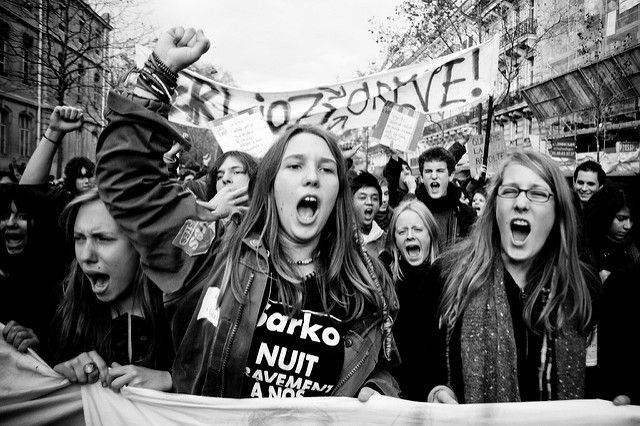 Image: own work
Image: own work
The report went on to focus on respondents from 13 countries to better understand what young people are optimistic and frustrated about in Europe. Among these countries, young people in Greece were “particularly interested in joining a large-scale uprising against their government, with 67% answering yes to the question.” Respondents in Greece were also more likely to believe politicians were corrupt and to have negative perceptions of the country’s financial sector.
Young people in Italy and Spain were next, with 65% and 63% willing to join a large-scale uprising, respectively. In France, a country that has revolution written into its DNA, 61% of the youth answered yes. But even in in the Netherlands, which has so far escaped the worst of the crisis, a third of young people agreed with the statement, rising to 37% in Germany and almost 40% in Austria.
During the election campaign, French teenagers held rallies in Rennes and other cities to protest against both presidential candidates. Some protesters blockaded schools, while others marched towards the city centre with placards that read “Expel Marine Le Pen, not immigrants” and “We don’t want Macron or Le Pen.” The report notes that respondents from France complained of a number of negative developments—too much corruption, too many taxes, too many rich people—compared to the rest in the EU.
These figures indicate that a profound change is taking place. The report concludes: “Voter apathy among the young has long been described as a worrying trend. In the UK, for example, youth turnout rates at general elections fell by 28 percentage points, from 66% in 1992 to 38% in 2005. But this declining electoral participation is not necessarily evidence of political apathy.”
The problem of leadership
Some superficial people have asked: “if things are so bad, why has there not been a revolution?” The ruling class was congratulating itself that this has not happened, since they initially feared the worst. And since the worst did not immediately materialise they breathed a sigh of relief and returned to the merry carnival of money-making, while everybody else has seen their living standards and future prospects crushed. In other words they behave like a man who is sawing off the branch he is sitting on.
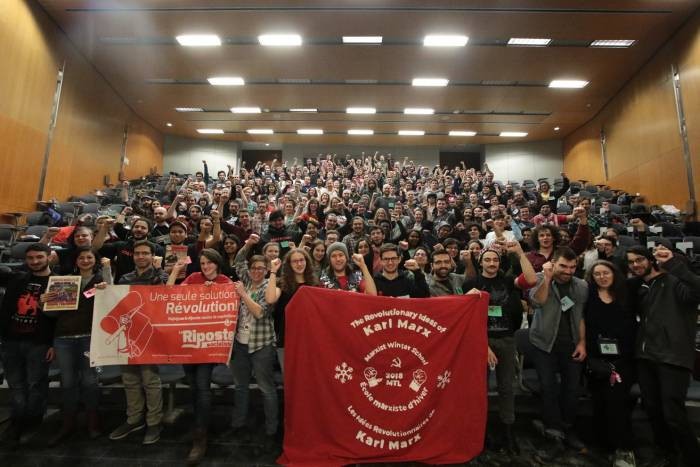
In reality there is nothing surprising about the delay in the process of revolution. Over many decades the bankers and capitalists have built powerful defences for their system. They control the press, radio and television. They enjoy virtually limitless financial resources, which they use to buy the services of political parties – not only of the right but of the “Left”, and also of many “responsible” trade union leaders. They can count on the support of university professors, lawyers, economists, bishops and the most privileged upper layers of the intelligentsia. And if all this fails, they can always resort to the policeman’s truncheon, the judges and the prison system.
But there is another, far more powerful barrier to revolution. Human consciousness, contrary to what the idealists think, is not progressive and certainly not revolutionary. It is innately and profoundly conservative. Most people are scared of change. Under normal conditions they will cling to the familiar, to what they know: familiar ideas, parties, leaders, religions. This is quite natural and reflects an instinct for self-preservation. It goes back into the days when we lived in caves and feared the dark recesses where dangerous animals lurked.
There is something comforting in routine, habit and tradition, in treading the old, well-known paths. As a rule, people will only accept the idea of change on the basis of great events that shake society to its foundations, transforming consciousness and forcing people to see things as they really are. This does not occur gradually, but in an explosive way. And that is precisely what we see now taking place everywhere. Consciousness is beginning to catch up with a bang.
The most important question is the question of leadership. In 1914 the German army officers described the British army in France with the following phrase: “Lions led by donkeys.” And that’s a very good description of the working class everywhere. The reformist leaders play a most pernicious role, clinging to the “free market” even when it is collapsing all around them.
The right-wing reformist leaders are completely corrupt. They abandoned all pretence to stand for socialism decades ago and become the most faithful servants of the bankers and capitalists. They willingly take upon their shoulders the responsibility for cuts in welfare spending and attacks on living standards in order to defend capitalism. But in so doing they discredit themselves in the eyes of the masses who earlier supported them.
There was a clear logic in this. In a period of capitalist upswing it was possible to make concessions to the working class, especially in the advanced capitalist countries of North America, Europe and Japan. But in a period of deep crisis the bourgeois say they can no longer afford reforms. On the contrary, they demand the liquidation of those reforms that were won since 1945. For the masses, reformism with reforms makes sense. But reformism without reforms, or rather, reformism with counter-reforms, makes no sense at all.
The long period of capitalist upswing that followed the end of the Second World War set the final seal on the degeneration of the Social Democracy. This degeneration has penetrated deep into its ranks. Most of the older activists in the Social Democratic parties and the trade unions have been demoralised by the previous period. They are disillusioned, disoriented and profoundly sceptical. They are completely out of touch with the real mood and they do not reflect the class.
This layer of activists never understood anything. They do not represent the present or the future but are only a reflection of the demoralization of past defeats. The situation is even worse with the ex-Stalinists, who have completely abandoned any socialist perspective or revolutionary class instinct they may once have possessed. Some of them may come back into activity when the class struggle rises. But mostly these and left-reformists and ex-Stalinists are so deeply impregnated with the spirit of scepticism that they are an obstacle in the path of the militant workers and the youth who are seeking the road of socialist revolution.
Our position as a revolutionary organization cannot be determined or influenced in any way by the prejudices of this layer. Our tactics are based on the real situation: the organic crisis of capitalism, which in turn is producing a new generation of class fighters, which will be far more revolutionary than the older generation ever was. We must base ourselves on the youth: both the students and school students and above all the working class.

